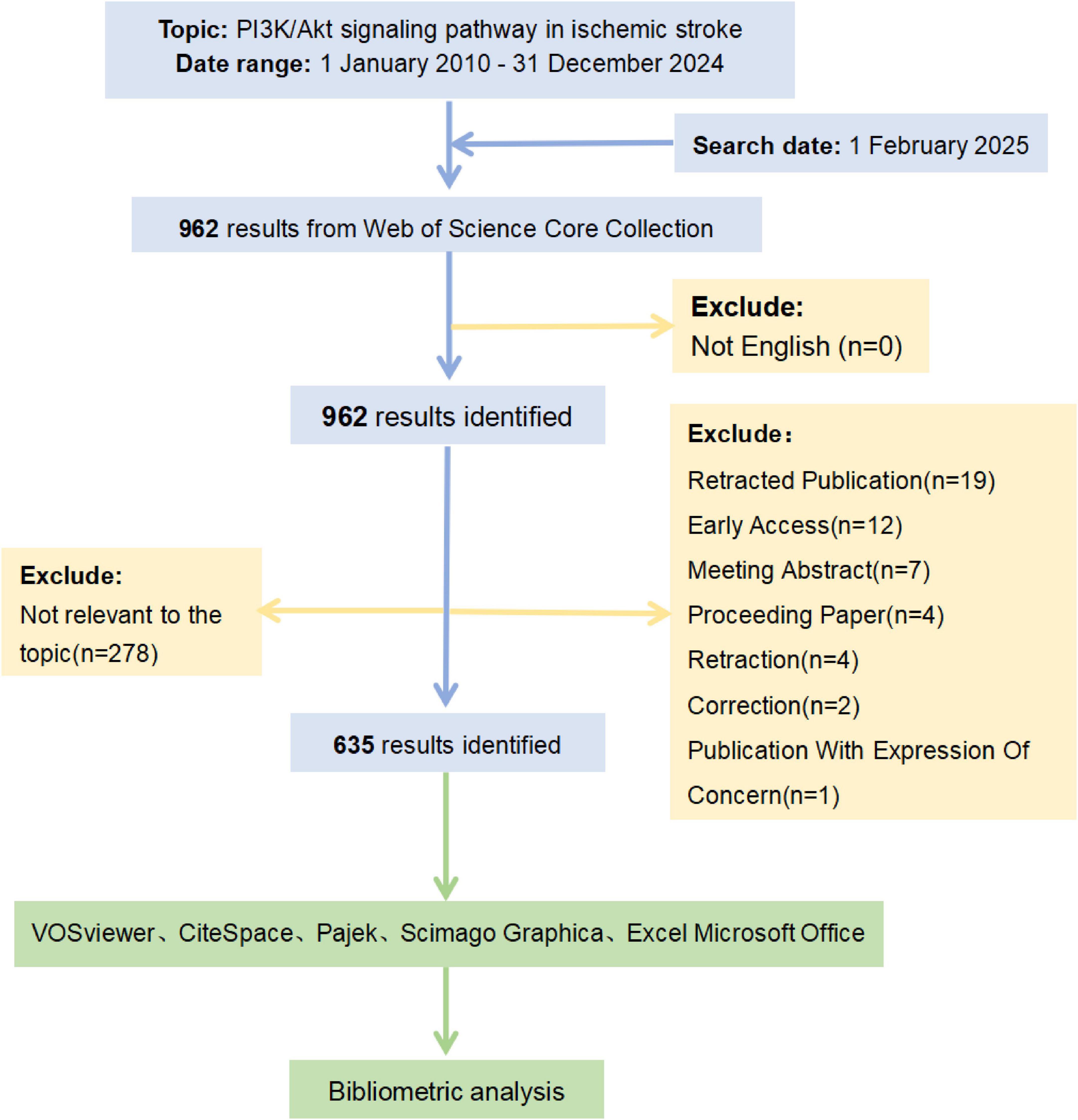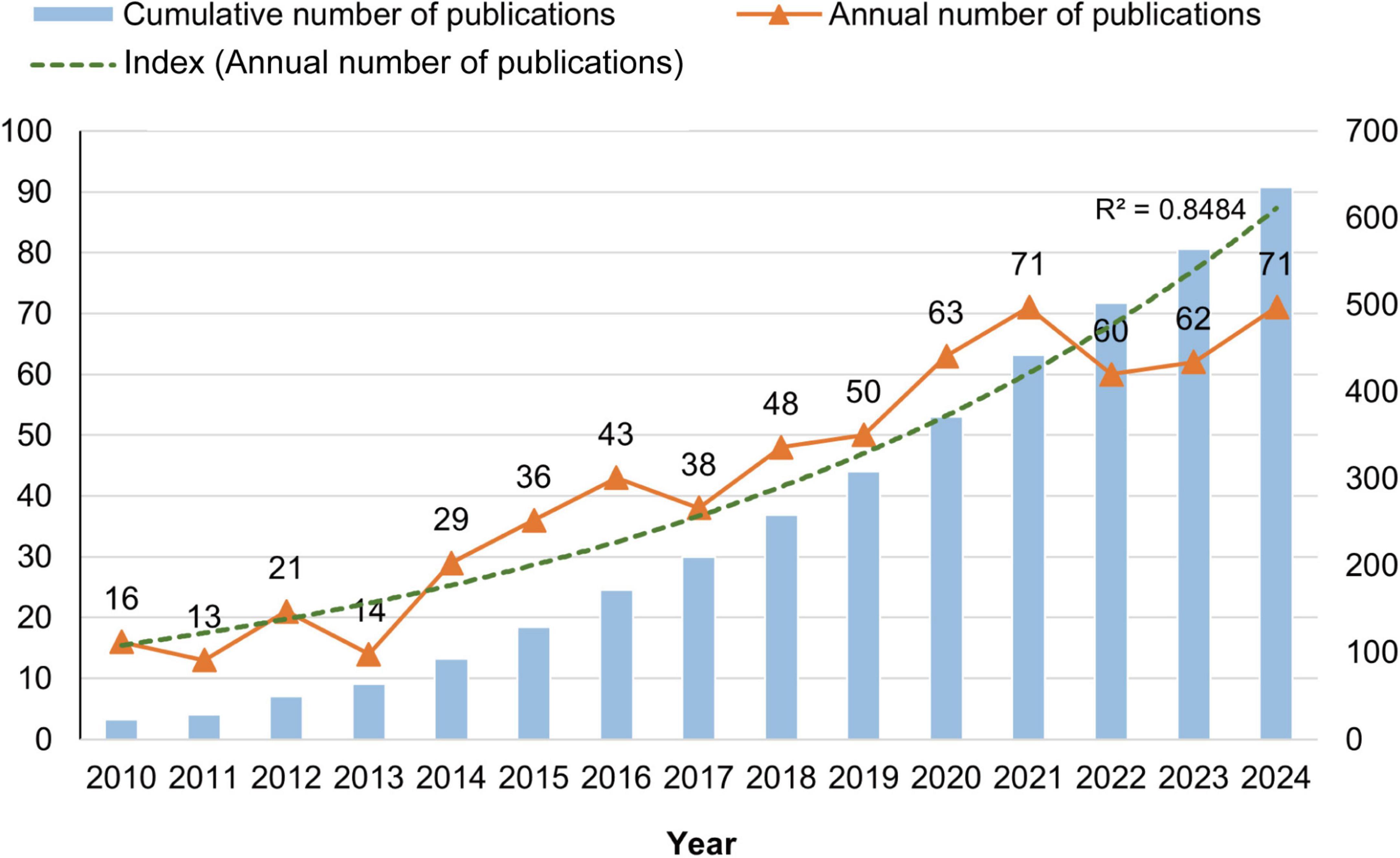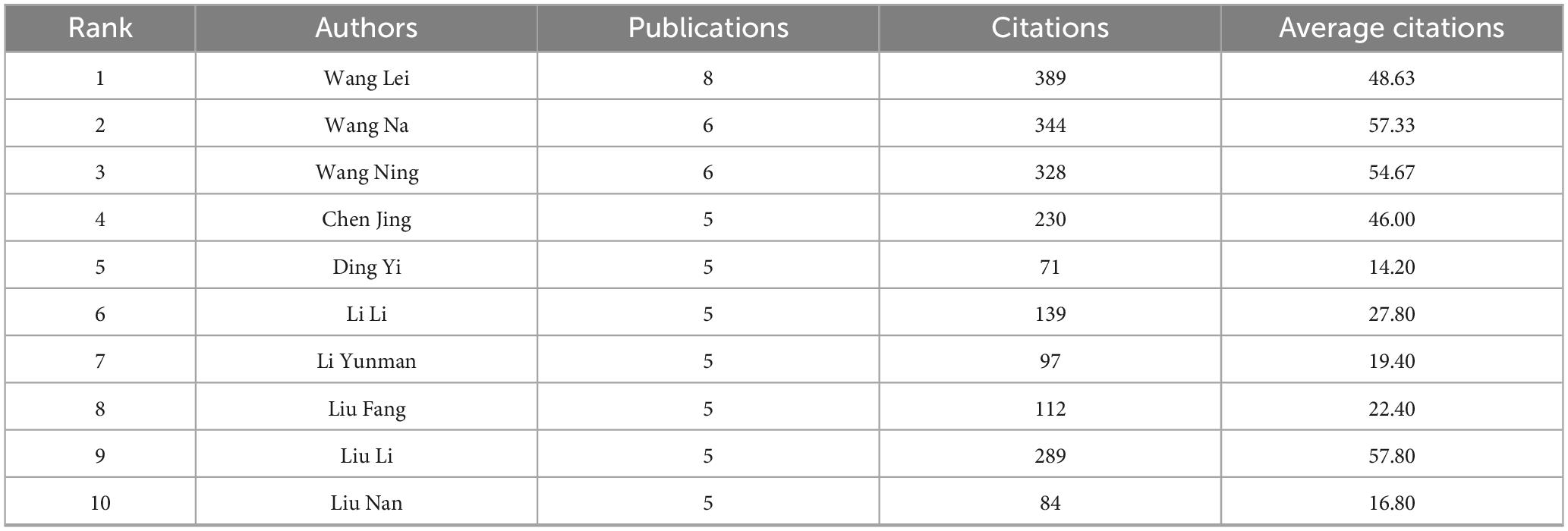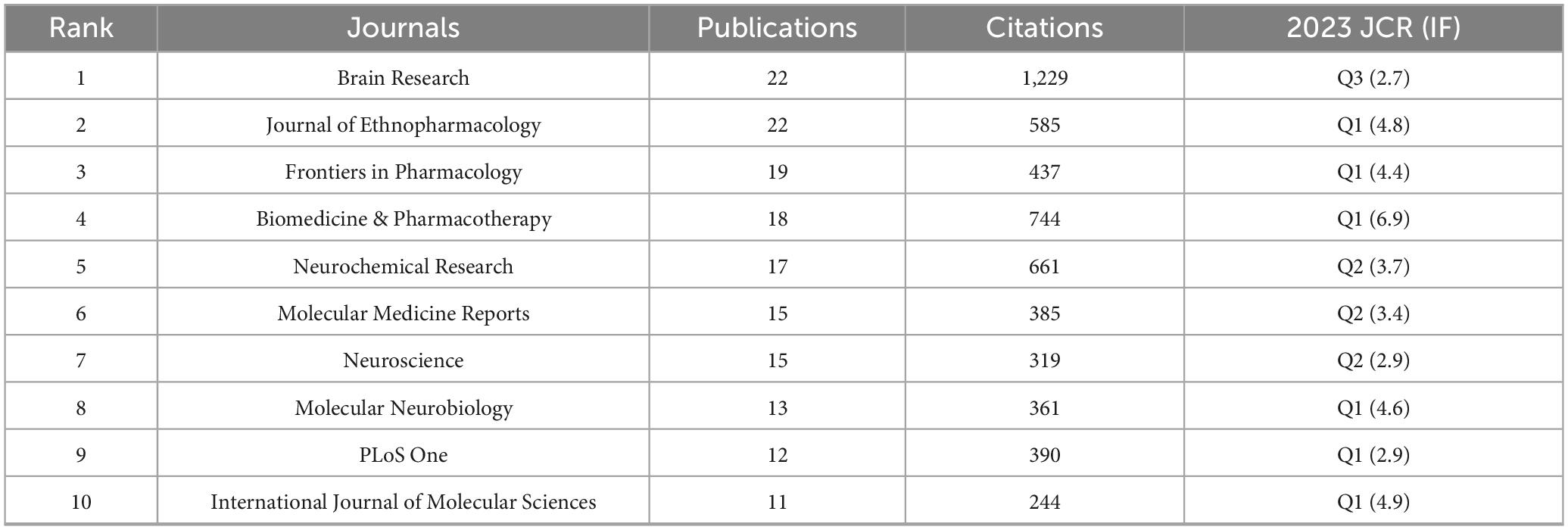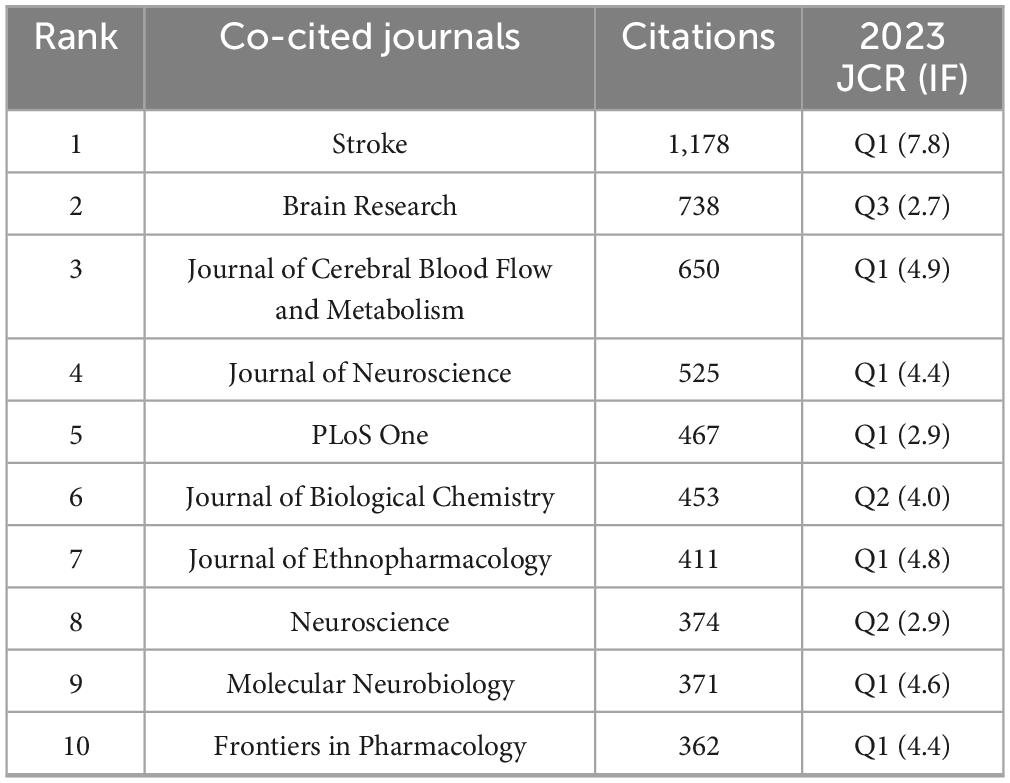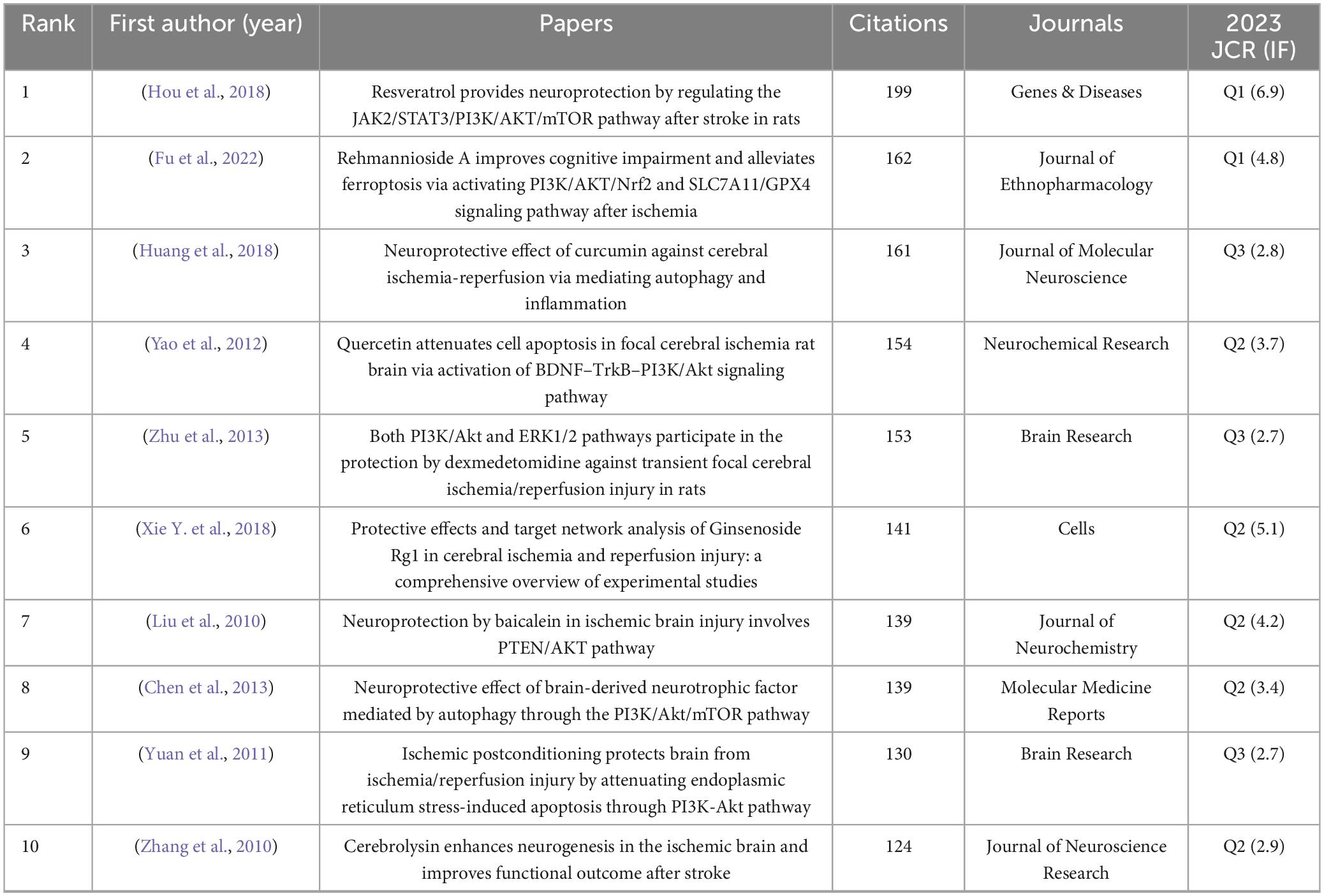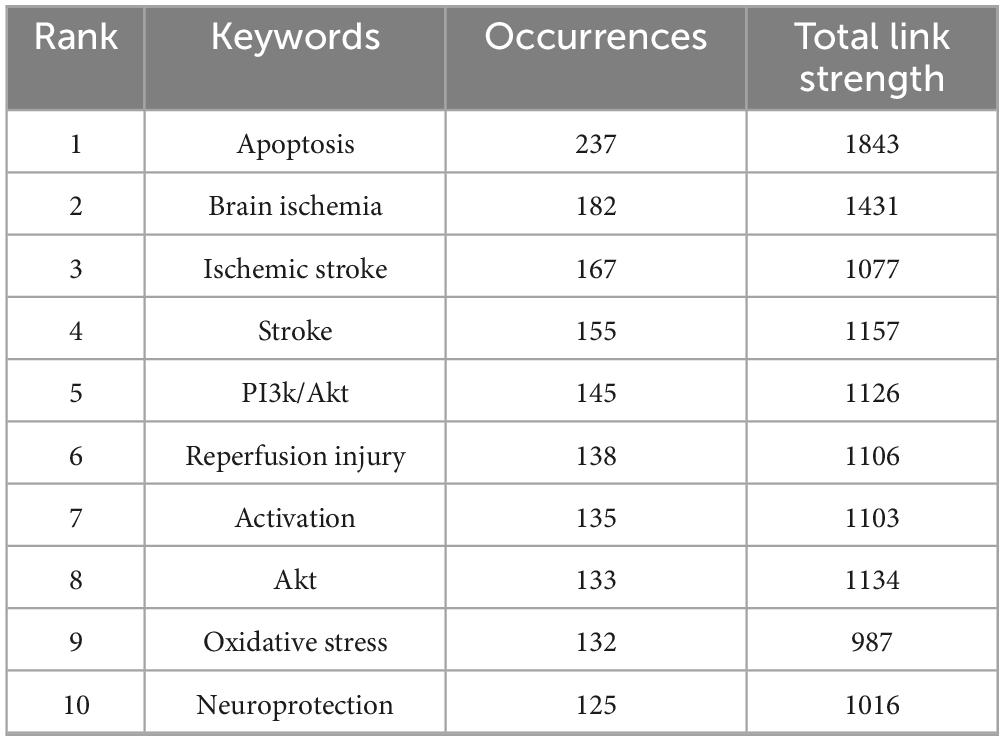- 1The First Clinical College of Anhui University of Chinese Medicine, Hefei, China
- 2Graduate School Anhui University of Chinese Medicine, Hefei, China
- 3The Second Affiliated Hospital of Anhui University of Chinese Medicine, Hefei, China
Objective: This study explores potential therapeutic strategies by determining the current research status, hotspots, and development trends through bibliometric analysis of the PI3K/Akt in ischemic stroke (IS).
Methods: We searched the Web of Science Core Collection for publications on IS and the PI3K/Akt pathway, covering January 1, 2010, to December 31, 2024. VOSviewer and CiteSpace software were used to analyze research hotspots and cutting-edge topics in the field and generate visual maps of relevant countries, institutions, authors, journals, keywords, and references.
Results: A total of 635 publications were analyzed. The number of publications indicates a steady annual increase in research output. China, Capital Medical University, and Wang Lei were identified as the most prolific country, institution, and author, respectively. The top three contributing journals were Brain Research, Journal of Ethnopharmacology, and Frontiers in Pharmacology. Autophagy, microglia and neuroinflammation, bioinformatics approaches, and traditional Chinese medicine (TCM) are not only current research areas but also important trends for future research. Notably, targeting IS with TCM holds significant potential for translating basic research findings into clinical applications.
Conclusion: This bibliometric analysis provides an in-depth overview of research on the PI3K/Akt pathway in IS, revealing current research status, hotspots, and future research trends. This will provide valuable guidance and direction for developing novel therapeutic strategies targeting this pathway.
1 Introduction
Stroke is the second leading cause of death worldwide, and its incidence is closely related to the level of economic development. In low-income countries, about 20% of the population may be affected by stroke, while in high-income countries, this proportion is higher than 30% (Hilkens et al., 2024). More than 75% of stroke cases are ischemic stroke (IS) caused by arterial blockages (Xu et al., 2020)(Xu et al., 2020). IS is caused by three major vascular factors: large artery disease, cardiogenic embolism, and small vessel disease (Hilkens et al., 2024). Inadequate or disrupted cerebral blood supply triggers a cascade of signal transduction events, leading to irreversible brain damage, neurological deficits, or even death (Liu et al., 2025). Clinically, pharmacological thrombolysis is the primary treatment for IS. However, its therapeutic window is only about 4 h, and the high risk of bleeding significantly limits its effectiveness (Wu et al., 2020). Therefore, novel therapeutic approaches to prevent and/or treat IS are urgently needed.
Phosphoinositide 3-kinase (PI3K) is a class of plasma membrane-associated lipid kinases comprising two regulatory subunits (p38 and p55) and a catalytic subunit (p110) (Yang et al., 2019). Phosphoinositide 3-kinase induces conformational changes in protein kinase B (Akt), leading to its phosphorylation, activation, and binding to the cellular membrane (Xie Y. et al., 2018). The PI3K/Akt signaling pathway (hereinafter referred to as PI3K/Akt) is an essential intracellular regulator of cell proliferation, differentiation, chemotaxis, survival, metabolism, and angiogenesis (Katso et al., 2001; Engelman et al., 2006). The pathogenesis of IS is complex, involving inflammatory responses triggered by cerebral ischemia, toxic effects of excitatory amino acids, oxidative stress, autophagy, apoptosis, and vascular endothelial stability (Liu T. et al., 2023). The PI3K/Akt is significantly involved in the pathological mechanisms of IS and, therefore, has become the focus of recent research (Xie Y. et al., 2018; Zheng et al., 2024). However, the current understanding of the PI3K/Akt in IS is still in its early stage. Therefore, an in-depth study of its role in IS holds significant promise.
Bibliometrics is a widely used statistical method for analyzing knowledge accumulation and research trends in a given field (Chen and Song, 2019). Recently, bibliometrics has been applied to IS research (Chen et al., 2023). However, a comprehensive bibliometric analysis of IS’s PI3K/Akt remains lacking. This study’s systematic bibliometric analysis of literature on the PI3K/Akt in IS was performed to assess the current status and global research trends. The findings will enhance researchers’ understanding of the PI3K/Akt and contribute to identifying novel strategies for IS prevention and treatment.
2 Materials and methods
This study did not involve animal experiments or human testing, so ethical review was not required.
2.1 Data collection and standardization
This study was searched based on the Web of Science Core Collection (WoSCC). The database features a strict journal selection mechanism and a standardized citation data system, which effectively ensures the homogeneity of bibliometric indicators and makes it the preferred choice for bibliometric research (Zhang et al., 2021; Yang J. et al., 2022; Veiga-del-Baño et al., 2023). Due to some delay in database inclusion, this may lead to systematic bias. To ensure that updates to the database have stabilized, a certain amount of time needs to be allowed for the deadline (December 31, 2024) set by this study for literature inclusion (Lv et al., 2025). Therefore, publications on PI3K/Akt in IS were searched and screened in the WoSCC database on February 1, 2025, for this study. Also excluded due to the small number of publications in this area before January 1, 2010. The search formula used was as follows: TS = (“PI3K/AKT” OR “PI3K/Akt” OR “PI3K-Akt” OR “Phosphoinositide-3 Kinase/Akt” OR “Phosphatidylinositol 3-Kinase/Akt” OR “Phosphoinositide-3 Kinase/protein kinase B” OR “Phosphatidylinositol 3-Kinase/protein kinase B” OR “Phosphoinositide-3 Kinase/serine/threonine kinase” OR “Phosphatidylinositol 3-Kinase/serine/threonine kinase” OR “Phosphatidylinositol 3-Kinase/serine/threonine protein kinase” OR “Phosphatidylinositol-3-hydroxykinase/protein kinase B”) AND TS = (“ischemic stroke” OR “Ischemic Strokes” OR “Stroke, Ischemic” OR “Acute Ischemic Stroke” OR “Acute Ischemic Strokes” OR “cryptogenic ischemic stroke” OR “cryptogenic stroke” OR “cryptogenic embolism stroke” OR “wake up stroke” OR “wake-up stroke” OR “brain ischemia” OR “cerebral ischemia” OR “cerebral stem ischemia”). Based on the given timeframe and search terms, 958 relevant publications on the PI3K/Akt in IS were retrieved from the WOSCC database. Subsequently, we screened the 958 publications based on language type, publication type, and relevance to the search topic. Finally, 635 publications were identified for inclusion in this study’s bibliometric analysis. The complete records of the retrieved publications were exported in “txt” format for subsequent analyses.
In this study, the names of countries/regions and keywords were identified through VOSviewer software. The data were cleaned up using the merge and modify functions of the “thesaurus file.” For the names of countries/regions: (1) Replace the names of countries with internationally recognized names, e.g., replace “Peoples R China” with “China.” (2) The names of regions should be harmonized with the name of the country to which they belong, e.g., “Scotland” and “England” should be unified as “United Kingdom.” For keywords: (1) Combine synonyms according to the MeSH Thesaurus, e.g., “acute ischemic stroke” and “cerebral ischemic stroke” into “ischemic stroke.” (2) Merge of keywords with the same meaning but different forms of expression, e.g., “PI3K/Akt signaling” and “PI3K/Akt pathway” to PI3K/Akt; (3) The full name of the keyword is changed to an academically recognized abbreviation, e.g., “blood-brain barrier” is merged with “blood-brain-barrier” to become “BBB.” (4) Unification of plural forms of nouns into singular forms, e.g., “astrocytes” into “astrocyte.” (Supplementary file S1 lists the records of keyword merging and modification).
2.2 Visualization tools and analysis
The main bibliometric analysis and data visualization tools used were VOSviewer software (version 1.6.19) and CiteSpace software (6.4.R1 advanced version). VOSviewer was used to construct a visual knowledge graph encompassing country, organization, author, co-citation author, journal, co-citation journal, and keyword co-occurrence network. Pajek (version 6.01) and Scimago Graphica (version 1.0.48) were used to refine clustering views for more intuitive visualization. CiteSpace primarily uses time-slicing techniques to construct a time series of network models, which evolve and integrate into a comprehensive overview network to analyze relevant literature systematically (Jiang et al., 2024). We used CiteSpace to generate a visual knowledge graph of journal biplot overlays and co-cited references. Meanwhile, we generated a cluster timeline by clustering the titles of the co-cited references. Additionally, we used CiteSpace to perform “burst detection” on keywords and references. To further characterize the data, we used Microsoft Office 2021 to analyze the exported data from VOSviewer and CiteSpace and construct a table of relevant analyses. A total of 635 articles on the PI3K/Akt in IS were analyzed, far exceeding the minimum recommended sample size of 200 for textual metrics analysis. Accordingly, the feasibility of this study was fully guaranteed. Figure 1 illustrates the flowchart for screening and analyzing the papers.
3 Results
3.1 Publication trends
The search and screening of relevant literature from 2010 to 2024 yielded 635 publications, including 594 original articles (93.54%) and 41 reviews (6.46%). The number of publications was 16 in 2010, peaking at 71 in 2021. Although a slight decline occurred in 2022 (60 publications) and 2023 (62 publications), the number of publications rebounded to 71 in 2024, indicating sustained research interest. Figure 2 presents the annual publication trend of PI3K/Akt studies in IS. Overall, the number of published studies on PI3K/Akt in IS is increasing, with more relevant studies expected to be published in the future.
3.2 Analyze of countries and institutions
Between 2010 and 2024, 38 countries published research on the PI3K/Akt in IS. The network of national collaborations was generated using VOSviewer, and Scimago Graphica was used to generate a map of the world’s geographical distribution of the research results. Figure 3a illustrates the distribution of countries contributing to this field on a global scale. Table 1 and Figure 3a present the top 10 most productive countries in this field, with China (533 papers), the United States (54 papers), and South Korea (26 papers) contributing the most. Although Japan published nine papers, none involved collaboration, suggesting that they need to be more actively involved in international collaboration to promote further development in this field. Citation analysis revealed that the United States has the highest average number of citations per paper (43.20), followed by the United Kingdom (39.17) and Australia (39.14) (Table 1). Figure 3c presents the collaboration among the top 10 countries in terms of published literature. Each node represents a country, with node size corresponding to publication volume and the thickness of the connecting lines reflecting the strength of collaboration. Figures 3b,c depict a wide range of cooperation among different countries, with China and the United States exhibiting the closest cooperation, indicating their crucial role in international cooperation.
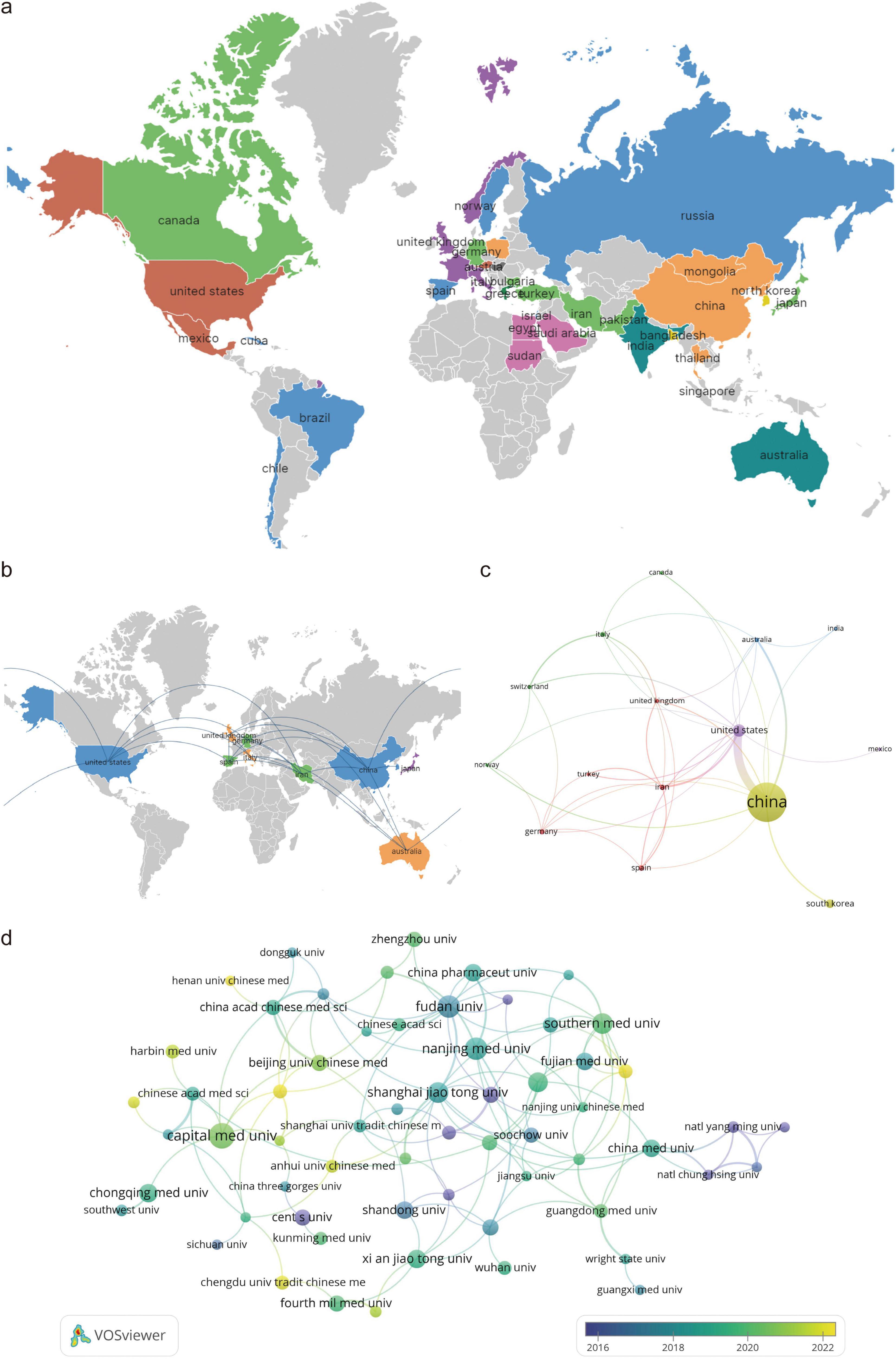
Figure 3. Visualization of countries and institutions involved in PI3K/Akt signaling pathway research in ischemic stroke (2010–2024); (a) geographic map of the global distribution of research results generated using VOSviewer with Scimago Graphica; (b) geographic map of global cooperation, generated using VOSviewer with Scimago Graphica, showing the cooperation between the 10 productive countries in this field; (c) cooperation network of different countries in the field generated using VOSviewer, where larger nodes represent more published table papers for the country and wider connecting lines between nodes indicate closer cooperation between countries; (d) timeline map of the cooperation network among different institutions generated using VOSviewer, where the closer the node color is to yellow, the later the year of collaboration.
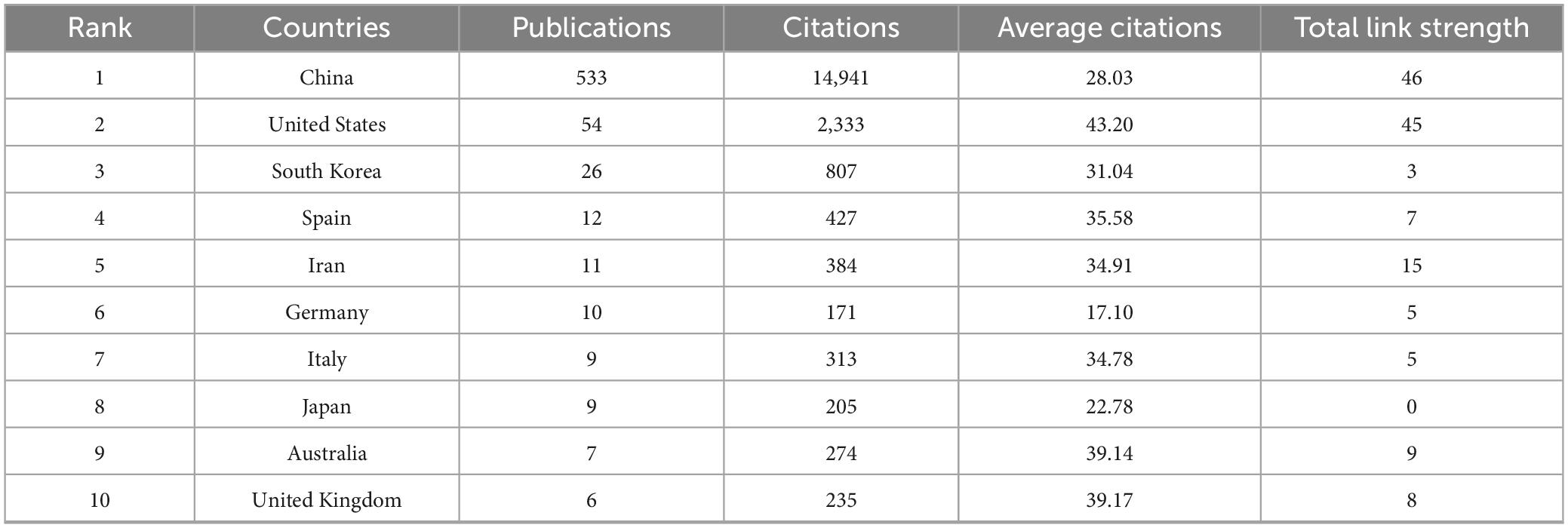
Table 1. Top 10 most productive countries in PI3K/Akt signaling pathway research in ischemic stroke.
VOSviewer analysis identified 746 institutions contributing to the 635 papers. Table 2 lists the top 10 institutions in terms of the number of papers, all of which are based in China. Figure 3d depicts the network of institutional collaborations, revealing a dense network of collaborations primarily among Chinese institutions. These findings suggest that China plays a central role in PI3K/Akt research in IS. Strengthening collaborations with Chinese institutions could accelerate progress in this field. Figure 3d indicates that the widest distribution of links occurs in the yellow and green marked years, indicating that inter-institutional collaboration was most frequent between 2018 and 2020 and has continued beyond this period. Citation analysis of institutions (Table 2) reveals that Fudan University has the highest number of citations (557), followed by Capital Medical University (552), and Hebei Medical University (487).
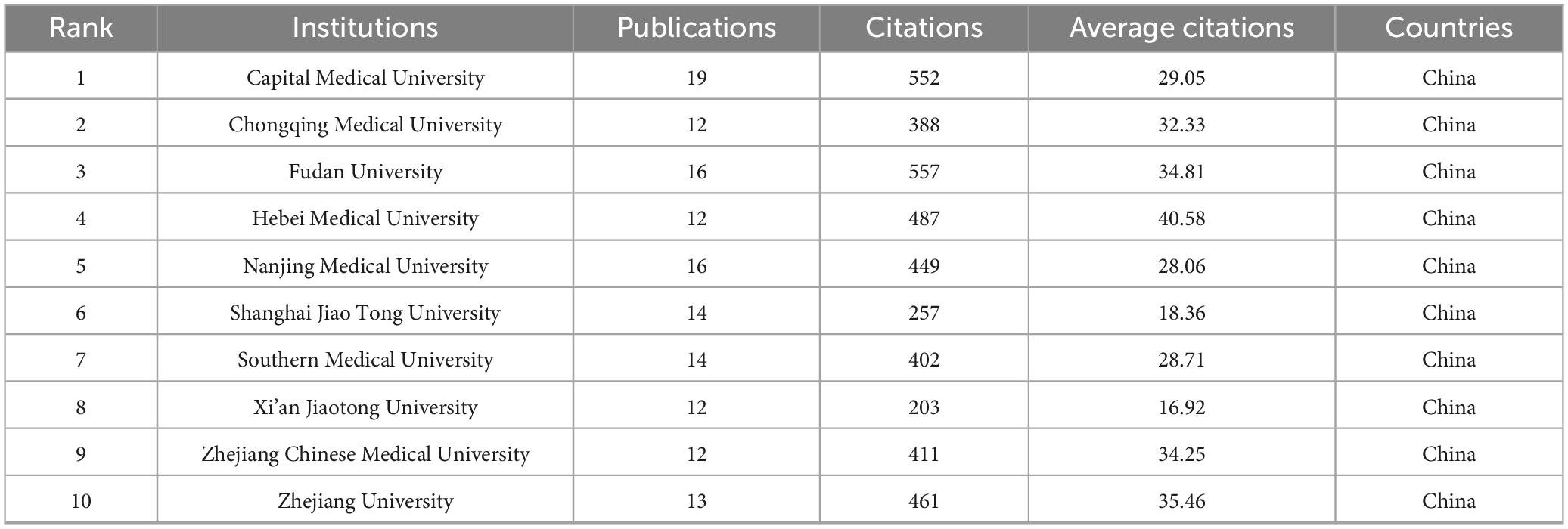
Table 2. Top 10 most productive institutions in PI3K/Akt signaling pathway research in ischemic stroke.
3.3 Analysis of authors and co-cited authors
To construct a visual network map of authors and co-cited authors in PI3K/Akt research in IS, we used the VOSviewer visualization software and adjusted the clustering view using Pajek to make it more intuitive and clearer. The field comprises 3,885 authors. Table 3 lists the top 10 most prolific authors, with Wang Lei leading with 8 papers, followed by Wang Na and Wang Ning with 6 papers each. Chen Jing, Ding Yi, Li Li, Li Yunman, Liu Fang, Liu Li, and Liu Nan have each published five papers. Price’s law states that the minimum number of publications by core authors in a given field, m, is proportional to the square root of the number of publications by the most prolific authors, nmax which is given by m = 0.749 × (Xu et al., 2024). Core authors in the field have at least 3 publications each (rounded upwards). Figure 4a illustrates the collaborative network of the 142 core authors, and it is evident that there are weak collaborative relationships between these core authors. This suggests that more cooperation and communication are required to expedite progress in the field. In terms of authors’ influence, Wang Lei has the highest number of citations at 389, while Liu Li has the highest average number of citations at 58 (Table 3), suggesting that their research findings have a significant international influence. Figure 4b demonstrates the network mapping of the co-cited authors, revealing three clusters. Among the 18,627 co-cited authors, 87 have been cited at least 20 times, with EZ Longa being the most cited (127 citations). Longa developed the middle cerebral artery occlusion model (MCAO) in 1989, a small-animal model of cerebral ischemia (Longa et al., 1989), which remains widely used worldwide.
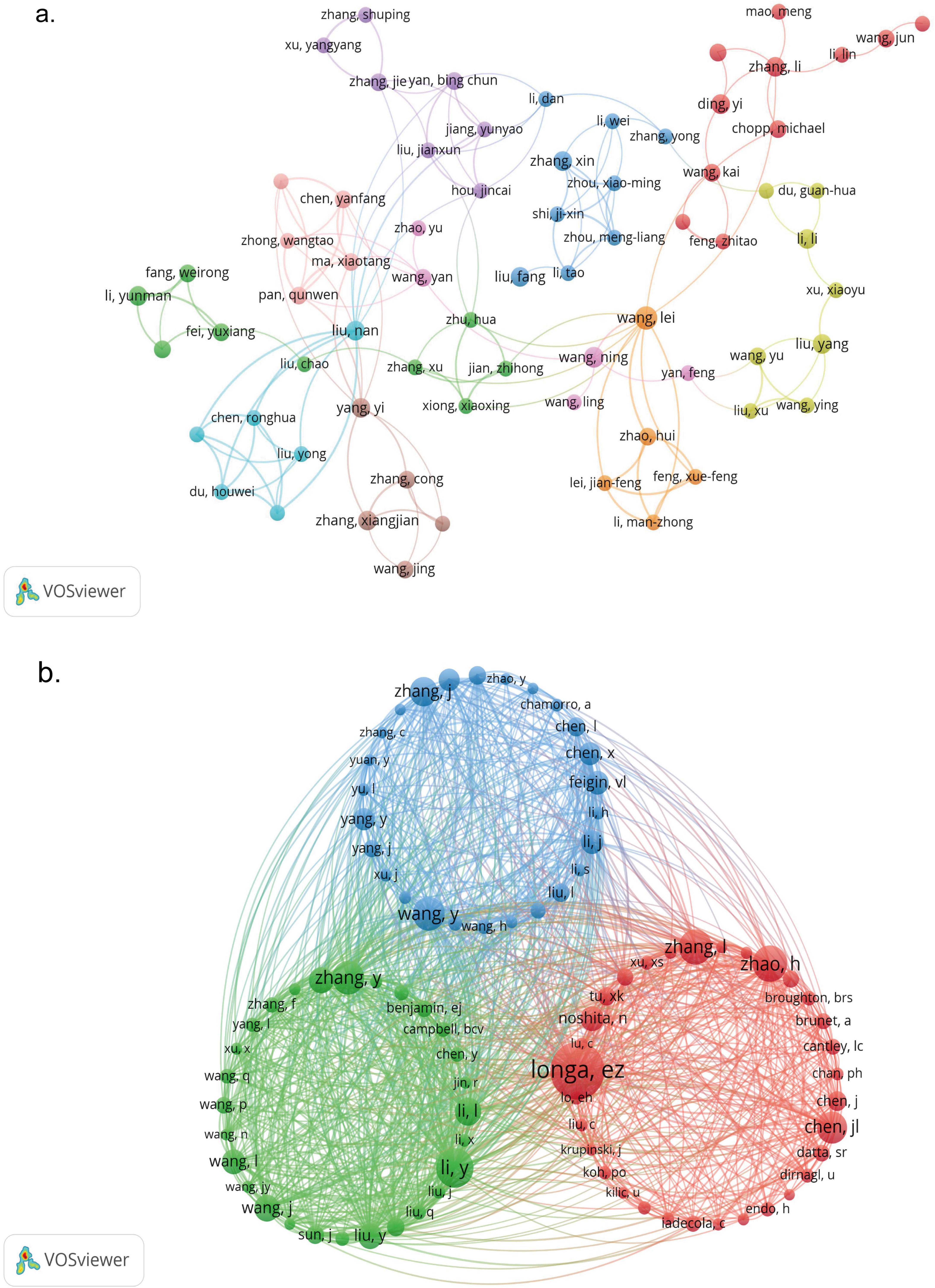
Figure 4. Visual network mapping of authors and co-cited authors in PI3K/Akt signaling pathway research in ischemic stroke; (a) network of authors with at least three publications generated using VOSviewer. Different nodes in the graph represent different core authors and different color bands indicate different collaborative clusters; (b) network of co-cited authors with at least 20 citations generated using VOSviewer and Pajek. Different nodes represent different co-cited authors, node size is proportional to the number of citations, and different color bands represent different clusters.
3.4 Analysis of journals and co-cited journals
A total of 231 journals published papers on the PI3K/Akt in IS, with 36 journals publishing at least 5 papers (Figure 5a). Table 4 depicts the top 10 journals in terms of publications. The top 10 journals published 164 articles in the field, accounting for 25.83% of the total number of publications. Brain Research (22 papers), Journal of Ethnopharmacology (22 papers), and Frontiers in Pharmacology (19 papers) were the most prolific. Among the top 10 journals, the impact factor (IF) ranged from 2.70 to 6.90. Six journals, including the Journal of Ethnopharmacology, Frontiers in Pharmacology, Biomedicine & Pharmacotherapy, Molecular Neurobiology, PLoS One, and International Journal of Molecular Sciences, were ranked in the Q1 division based on the 2023 Journal Citation Reports (JCR). As illustrated in Figure 5b, 170 of the 3,243 co-cited journals have at least 40 citations, with different clusters represented by distinct colors. Table 5 details the top 10 most cited journals. Of these, Stroke tops the list with 7,925 citations and is also the journal with the highest IF (7.8 in 2023). Neurorehabilitation and Neural Repair (3,263 citations) and Archives of Physical Medicine and Rehabilitation (3,057 citations) follow closely.
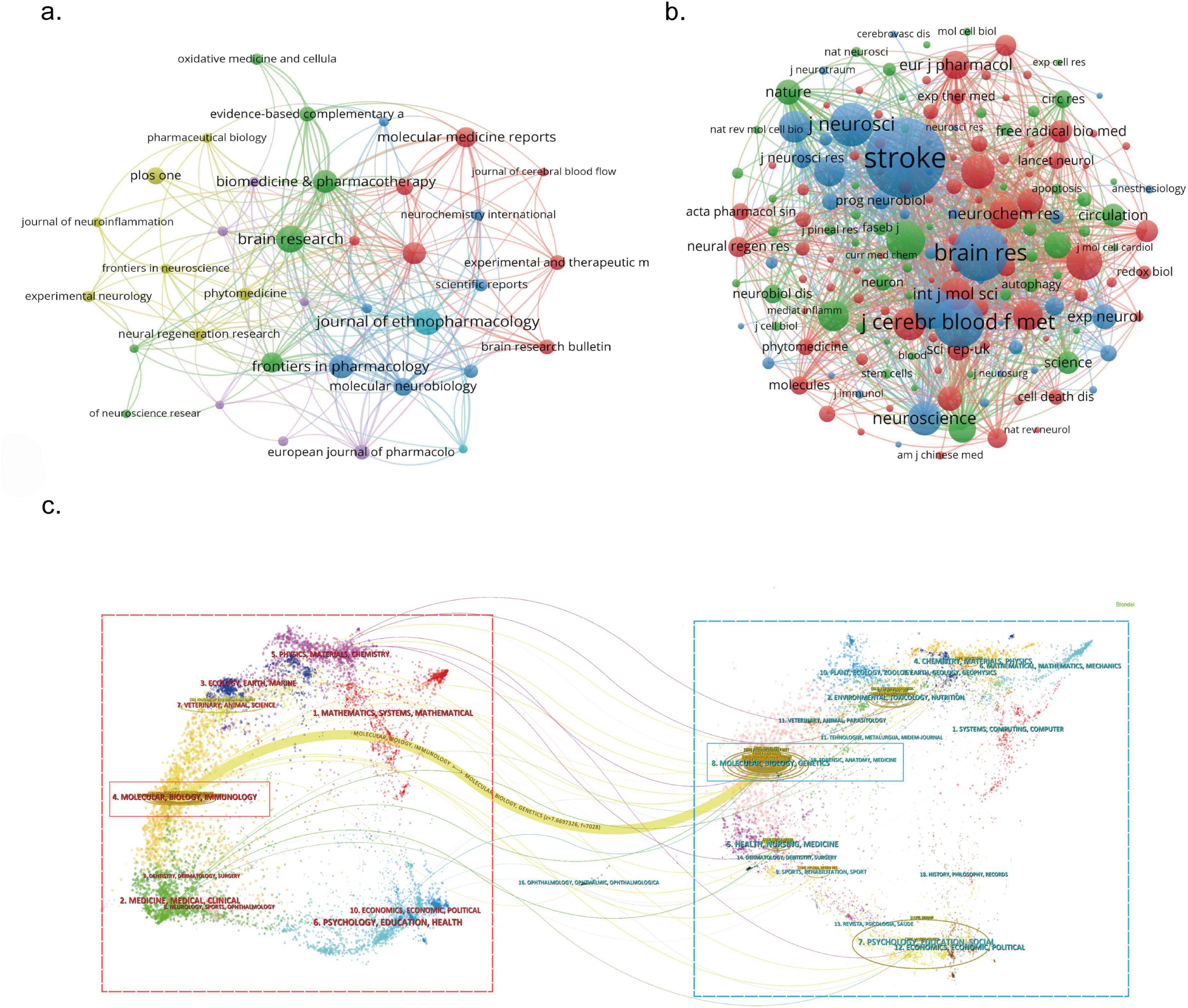
Figure 5. Visualized network mapping of relevant journals and co-cited journals in PI3K/Akt signaling pathway research in ischemic stroke; (a) network of journals that have published at least five papers generated using VOSviewer. Different nodes in the graph represent different journals, and the node size is proportional to the number of papers published in the journal; (b) network of co-cited journals with at least 40 citations generated using VOSviewer. Different nodes in the graph represent different co-cited journals, and the node size is proportional to the number of citations; (c) dual-map overlay of journals illustrating citation relationships between citing journals (knowledge frontier areas in red boxes) and cited journals (knowledge base areas in blue boxes). These citation links provide a visual representation of the interactions and connections between the topics of the two types of journals.
Figure 5c depicts a dual-map overlay of journals. The red dashed box on the left represents citing journals (knowledge frontiers), and the blue dashed box on the right represents cited journals (foundational areas of knowledge). The interactive colored citation links present the strength of the association between the topics of these journals. The most prominent yellow citation path extends from “Molecular, Biology, and Genetics” (knowledge base) to “Molecular, Biology, and Immunology” (knowledge frontiers). This suggests that research on the PI3K/Akt in IS has focused on genetic regulation and immune response and has resulted in a relatively dense knowledge output. However, translational research, including target drug development and drug delivery, remains limited, indicating a gap between basic research findings and clinical applications in this field.
3.5 Analyzing cited papers and keywords
We employed VOSviewer software to conduct a citation analysis of the 635 papers included in the study. Our objective was to identify high-impact papers in the field of PI3K/Akt research in IS. This will facilitate our understanding of the research hotspots and trends in this field (Ravindran et al., 2019). Table 6 presents the top 10 cited papers in the field. Hou et al. (2018) published in Genes & Diseases [Q1 (6.9)], garnered the highest citation count, with 199 citations recorded. Its research focuses on the mechanisms of apoptosis in this field. Fu et al. (2022) published in the Journal of Ethnopharmacology [Q1 (4.8)], despite its late publication (2022), has received 162 citations and is in second place. This suggests that ferroptosis, a regulatory mechanism, is an emerging trend in the field of PI3K/Akt research in IS in recent years. Huang LF (Huang et al., 2018) published in the Journal of Molecular Neuroscience [Q3 (2.8)] was ranked third with 161 citations. Its study is indicative of the elevated level of interest and activity in autophagy research within this field. A significant finding was that six of the 10 highly cited papers concentrated on the active ingredients of traditional Chinese medicine (TCM) and the PI3K/AKT pathway, covering a span of 13 years (2010–2022) (Liu et al., 2010; Yao et al., 2012; Hou et al., 2018; Huang et al., 2018; Xie Y. et al., 2018; Fu et al., 2022). This finding suggests that this line of research not only continues to receive attention but also shows great potential for translation from basic research to clinical applications.
Keywords in scientific research papers reflect the topics of study. Analyzing keyword frequency and co-occurrence helps identify popular topics and emerging trends in a research field (van Eck and Waltman, 2010). We used VOSviewer to visualize keyword co-occurrences in PI3K/Akt research in IS and Pajek to adjust the clustering view. A total of 2,624 keywords were identified over the 15 years from 2010 to 2024, with 198 keywords co-occurring at least 5 times. Table 7 lists the top 10 most frequent keywords, including apoptosis (237), P13K/Akt (145), reperfusion injury (138), activation (135), oxidative stress (132), and neuroprotection (125). Figure 6a presents the co-occurrence network mapping of keywords in this domain. The keywords with strong relevance are grouped into seven colored clusters, all of which contain more than 15 keywords. The red cluster (41 keywords) is the largest and mainly focuses on PI3K/Akt activation to produce neuroprotection after cerebral ischemia/reperfusion injury, including terms brain ischemia, PI3K/Akt, activation and neuroprotection. The green keyword cluster (35 keywords) focuses on the neurorestorative effects of the PI3K/Akt pathway on stroke rats and in-vitro models. The keywords mainly include stroke, in-vitro, neurogenesis, angiogenesis, and rat. The blue cluster (30 keywords) focuses on the impact of oxidative stress and mitochondrial dysfunction on neuronal survival in this field, mainly involving the terms oxidative stress, focal cerebral ischemia, mitochondrial dysfunction, and cell-survival. The yellow cluster (27 keywords) focuses on neuronal apoptosis and expression in this field. The keywords cover apoptosis, expression, and caspase-3. The purple cluster (26 keywords) focuses on reperfusion injury and inflammation in this field and contains mainly the terms cerebral reperfusion injury, inflammation, and microglia. The cyan cluster (23 keywords) focuses on bioinformatics approaches to shed light on the protective mechanisms of the PI3K/Akt signaling pathway. The main terms involved are ischemic stroke, pathway, network pharmacology, and protects. The orange cluster (16 keywords) focuses mainly on autophagy mechanisms in reperfusion injury in this field. Terms such as autophagy, PI3k, Akt, mTOR. These results indicate research hotspots in this field.
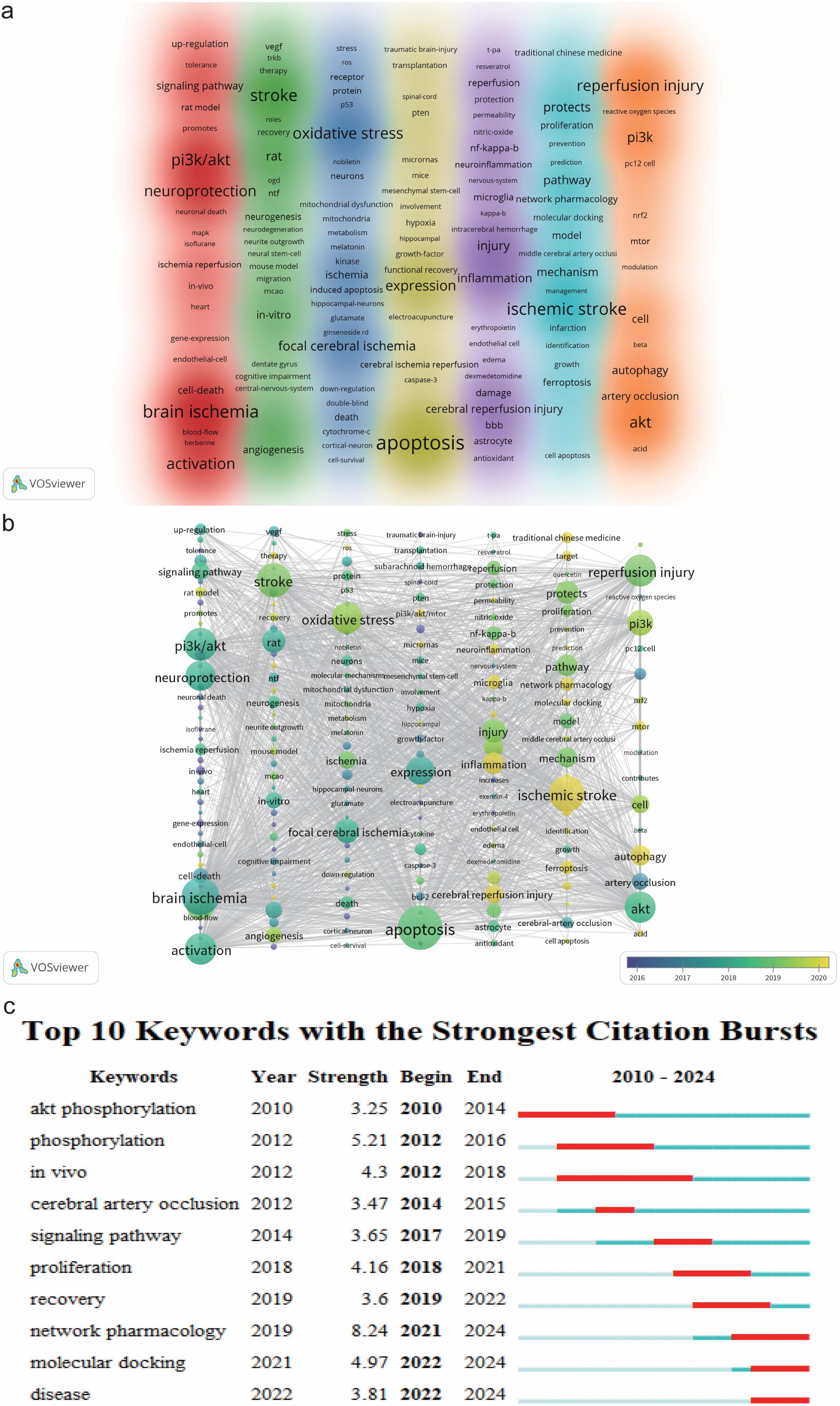
Figure 6. Visualization of keywords in PI3K/Akt signaling pathway research in ischemic stroke; (a) network mapping of keywords with a co-occurrence frequency of ≥ 5 generated by VOSviewer. Different colors in the graph represent different keyword clusters, and the darker the color and the more prominent the font, the higher the frequency of keywords; (b) temporal view of the keyword co-occurrence network generated using VOSviewer with Pajek. Larger nodes in the graph indicate a higher frequency of keyword occurrence, and the closer the node color is to yellow, the later the year of keyword occurrence; (c) Top 10 keywords in terms of burst strength mapped with the help of CiteSpace software. The higher the burst intensity of the keywords in the graph means that they have received more attention in a specific period. The start time reflects the duration of the keyword to maintain a high outburst status.
The temporal mapping of keyword networks was generated using VOSviewer based on the average year of first keyword occurrence, and the clustering layout was optimally adjusted using Pajek (Figure 6b). The figure depicts that since 2020, ischemic stroke, cerebral reperfusion injury, autophagy, inflammation, microglia, ferroptosis, network pharmacology, and traditional Chinese medicine (TCM) have been the frequently appearing keywords. This suggests that autophagy and neuroinflammation are not only current research hotspots but also future trends in PI3K/Akt studies in IS. Notably, the role of ferroptosis in this field is gradually expanding, indicating the potential for more relevant studies. Additionally, targeting the PI3K/Akt with TCM for IS treatment is expected to become a key direction for translating basic research findings into clinical applications. We generated the top 10 keywords in terms of burst strength using CiteSpace. Figure 6c depicts that keywords such as cyber pharmacology (burst strength of 8.24; 2021–2024) and molecular docking (burst strength of 4.97; 2022–2024) exhibited strong burst trends, which will probably continue in the future. This indicates that using bioinformatics approaches to investigate the targeting of PI3K/Akt by active ingredients of TCM and their application in IS treatment has become an important direction for future research in this field.
3.6 Analysis of co-cited references
Analysis of co-cited references helps to identify the knowledge base and influential articles within a large body of literature, enabling a comprehensive exploration of the field (Zhu et al., 2023). In total, 26,555 references were cited across 635 articles on the PI3K/Akt in IS. Using CiteSpace software, we mapped the co-citation network of these references (Figure 7a). Table 8 details the top 10 co-cited references based on high frequency and centrality, comprising 7 original articles and 3 reviews. It is noteworthy that Hou et al. (2018) attained the top position in terms of co-citation frequency (15) and centrality (0.27). Chen et al. (2019) was the runner-up, with a centrality of 0.25. These studies represent the core nodes in Figure 7a, which establish connections between diverse research directions and provide significant theoretical support and a bridging role for subsequent studies. Feng et al. (2020) exhibited the second-highest co-citation frequency (14), though its centrality (0.01) was minimal. In a manner analogous to Hou et al. (2018), Feng et al. (2020) concentrated on the neuroprotective effects of TCM by targeting the PI3K/Akt pathway. Chen et al. (2020) (centrality 0.11, ranked third) employed a research strategy that integrated proteomics analysis techniques with TCM.
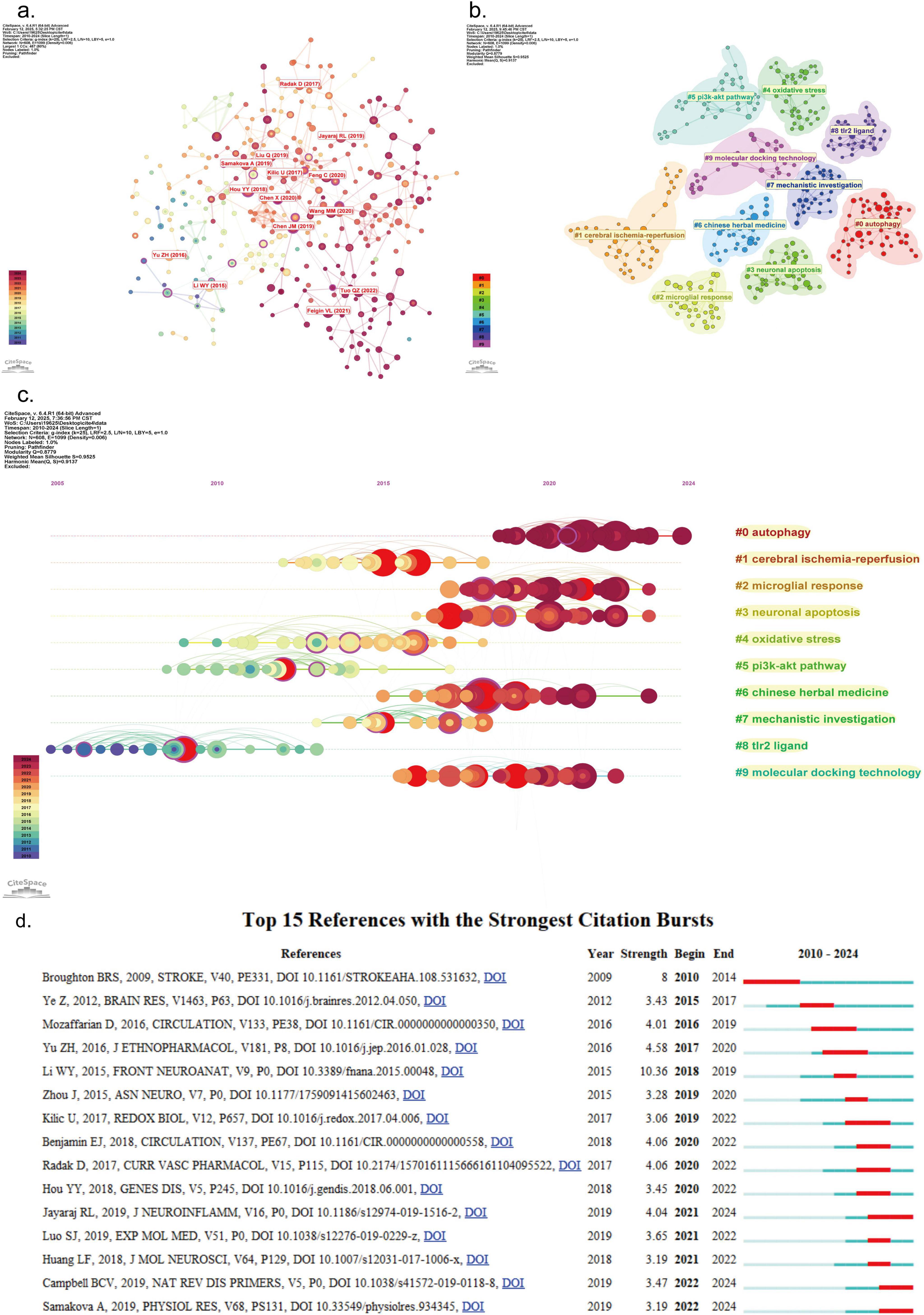
Figure 7. Visualization of co-cited references in PI3K/Akt signaling pathway research in ischemic stroke; (a) co-citation network of references mapped using CiteSpace software. The size of the nodes in the graph is proportional to the frequency of co-citation, while the connecting lines between the nodes indicate the correlation between different studies, with more connecting lines indicating higher centrality. (b) Distribution of the top 10 major clusters of co-cited references mapped using CiteSpace software; (c) timeline mapping of the top 10 major clusters of co-cited references plotted using CiteSpace software. The map illustrates the temporal progression of the clusters through horizontal arrangement, with nodes within the same cluster ordered from left (early) to right (recent) based on their respective publication times. The size of the nodes serves as an intuitive metric for assessing the popularity of literature during different periods. (d) Top 15 references with the strongest citation bursts. plotted using CiteSpace software. As illustrated in the graph, burst intensity is indicative of the amount of attention a reference has received during a specified period, while onset time signifies the duration of the elevated burst state.
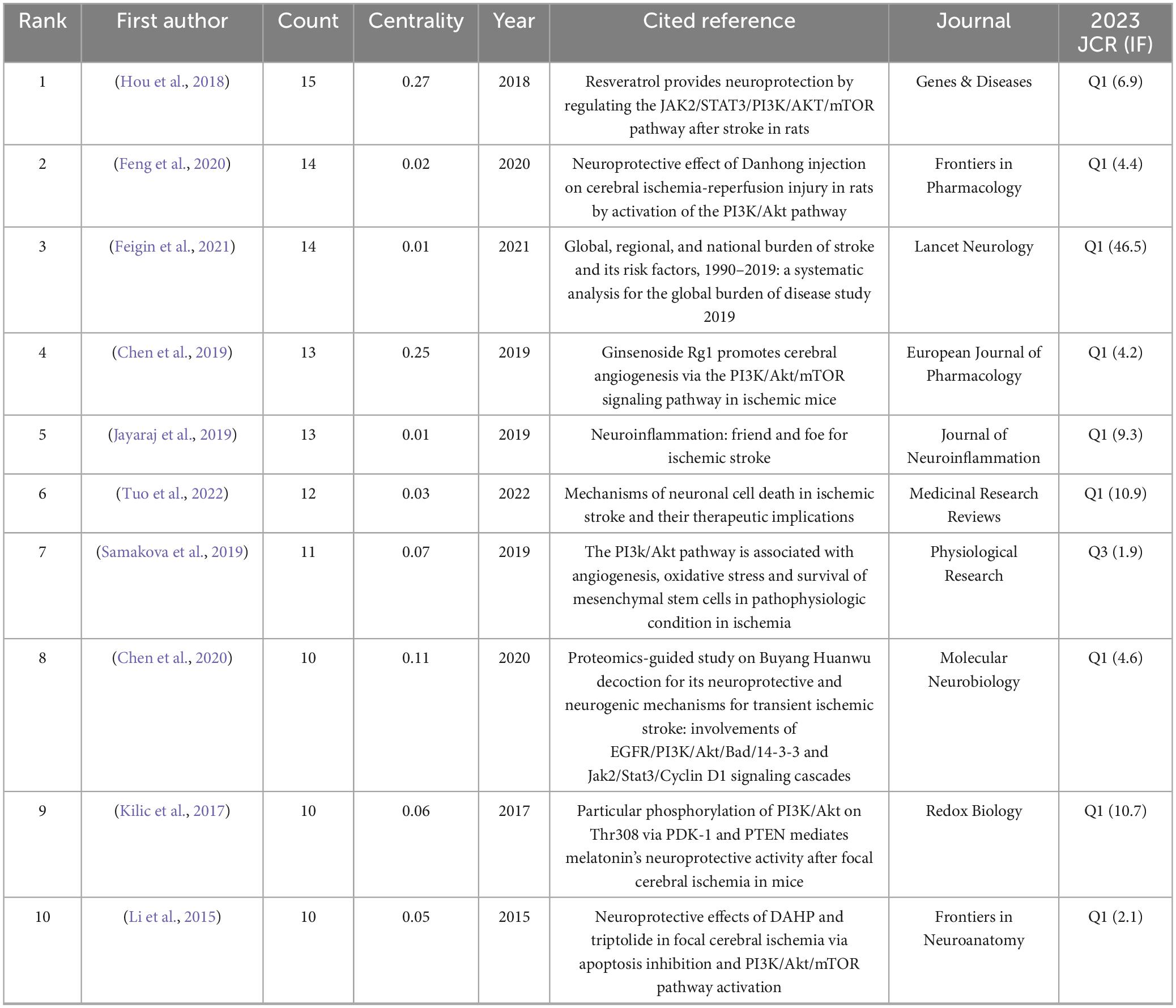
Table 8. Top 10 co-cited references based on high frequency and centrality in PI3K/Akt signaling pathway research in ischemic stroke.
To further investigate research hotspots, we used CiteSpace software to generate 22 clusters. The modularity value and weighted average profile value of the clusters were 0.8779 and 0.9137, respectively, indicating high clustering confidence. Figure 7b presents the distribution of the top 10 clusters. Similarly, in Figure 7c, the horizontal position of the nodes on the time axis represents when the references were cited, while node size represents the frequency of citation. Recent research hotspots in the PI3K/Akt in IS include cluster 0# (autophagy), cluster 2# (microglial response), cluster 3# (neuronal apoptosis), cluster 6# (Chinese herbal medicine), and cluster 9# (molecular docking technology).
A citation burst indicates a significant increase in attention to a specific article in a specific research area within a certain time frame (Xu et al., 2024). References with high values in the strength column are usually milestones in scientific cartographic research (Chen, 2004). Figure 7d presents the top 15 references with the strongest citation bursts. The earliest and longest-spanning reference is “DOI 10.1161/STROKEAHA.108.53163” (Broughton et al., 2009), with a citation burst concentrated between 2010 and 2014, focusing on apoptosis after stroke. The reference with the highest citation burst strength (10.36) is “DOI 10.3389/fnana.2015.0004” (Li et al., 2015), which focuses on neuroapoptosis by targeting the PI3K/Akt to provide neuroprotection against stroke. Notably, the reference “DOI 10.1186/s12974-019-1516-2” maintained a citation peak until 2024. It focuses on post-acute stroke neurological inflammatory mechanisms (Jayaraj et al., 2019). This suggests that inflammation is a current research focus in PI3K/Akt in IS and indicates future research directions.
4 Discussion
4.1 Summary of basic information
This study used bibliometrics to analyze 635 original articles and reviews on PI3K/Akt in IS from 2010 to 2024. The number of publications increased steadily each year, peaking in 2021 with 71 publications. Among the 38 countries analyzed, China ranked first with 533 publications, followed by the United States and South Korea. China and the United States exhibited the closest collaboration and made significant contributions to the field. The top 10 research institutions, including Capital Medical University, Chongqing Medical University, and Fudan University, are all based in China, and a relatively close network of cooperation has been established between these institutions. However, further international institutional collaboration is needed to advance the field. Analysis of authors and co-cited authors identified 3,885 authors and 18,627 co-cited authors. Wang Lei was the most prolific author, publishing 8 papers, while Liu Li had the highest average number of citations at 57.80. Among the co-cited authors, EZ Longa had the highest number of citations at 127. This fully reflects their influence and Contribution To The Field.
The 635 articles analyzed were from 231 journals. The top three journals in terms of publication volume were Brain Research, Journal of Ethnopharmacology, and Frontiers in Pharmacology, collectively accounting for 25.83% of all published articles, indicating their significant contributions to the field. Stroke was the most frequently cited journal, with 7,925 citations, highlighting its authority in PI3K/Akt research in IS. However, the dual-map overlay of journals revealed a gap between basic research findings and clinical applications.
4.2 Research hotspots
We identified several major hotspots for PI3K/Akt research in IS by visualizing and analyzing highly cited papers, keywords, and co-cited literature. These hotspots mainly focus on the pathological mechanisms and targeted therapies of IS.
4.2.1 Apoptosis
Apoptosis is an orderly and efficient process of programmed cell death under normal physiological conditions (Fleisher, 1997). It is responsible for removing damaged cells, and it is regulated by key apoptotic proteins (Elmore, 2007). However, in IS, neuroapoptosis occurs excessively (Elmore, 2007). Activation of the PI3K/Akt inhibits apoptosis in neuronal cells by upregulating the expression of anti-apoptotic proteins (e.g., Bcl-2) and downregulating pro-apoptotic proteins (e.g., Bax, caspase-3, and caspase-9) following PI3K/Akt phosphorylation, thereby inhibiting the apoptotic cascade (Yu et al., 2016; Xu et al., 2021). Excessive apoptosis of neuronal cells is a hallmark of ischemic/reperfusion (I/R) injury in IS. The PI3K/Akt, activated by miR-18b, reduced infarct size, attenuated neurological deficits, and inhibited apoptosis in a mouse MCAO model and an in-vitro oxygen-glucose deprivation/reperfusion model to prevent cerebral I/R injury (Min et al., 2020). However, a recent study published in Redox Biology reported that after MCAO induction, PI3K/Akt activation promoted astrocyte proliferation and the release of pro-inflammatory cytokines, including interleukin-1 beta (IL-1β), IL-6, and tumor necrosis factor-alpha (TNF-α), which exacerbated apoptosis and resulted in brain tissue damage (Cai et al., 2023). This seemingly contradictory finding may arise from the dual role of astrocytes, the most abundant glial cells in the mammalian brain, in IS recovery (Cai et al., 2023). Thus, PI3K/Akt activation after IS onset is not always beneficial to neuronal cells, and the different mechanisms involved in different cells can have different effects on the pathological mechanisms of IS. Further studies are needed to investigate this.
4.2.2 Autophagy
Autophagy is a crucial process that helps cells maintain intracellular homeostasis by degrading and recycling proteins and organelles (Liu S. et al., 2023). Autophagy has dual functions and typically protects cells. In IS, pathological factors, including oxidative stress, mitochondrial dysfunction, and endoplasmic reticulum stress, can dysregulate autophagic processes and over-activate autophagic fluxes, leading to necrotic and apoptotic cascade responses (Wang et al., 2018). The P13K/Akt is closely linked to autophagy in IS; however, its ability to regulate autophagy is typically dependent on the activation of downstream mTOR (a protein that maintains cellular homeostasis) (Perez-Alvarez et al., 2018). Autophagy-related proteins [for example, Beclin-1 and light chain 3 (LC3)] and apoptosis-related proteins are significantly overexpressed during cerebral I/R injury, while the anti-apoptotic protein is suppressed. However, activating the PI3K/Akt/mTOR can inhibit apoptosis and excessive autophagy induced by brain I/R injury, thereby protecting the neurons (He et al., 2019; Meng et al., 2021). In a study, the PI3K/Akt mitigated cerebral IS by moderately activating the autophagy mechanism, resulting in a neuroprotective effect (Zhao et al., 2023). This suggests that the role of autophagy in IS remains controversial and that its effects on neurorecovery are not entirely negative. This controversy may explain why autophagy has recently become a research hotspot in studies on the PI3K/Akt in IS.
4.2.3 Microglia and neuroinflammation
Microglia are resident innate immune cells in the brain that continuously monitor the brain’s microenvironment and respond to changes to maintain normal brain function. They are among the first cells to respond when IS occurs (Doyle et al., 2008). Microglia-mediated neuroinflammation is a significant cause of secondary brain injury during I/R. During this process, microglia differentiate into two distinct phenotypes depending on the surrounding environment: M1, which releases pro-inflammatory factors, such as CD86, iNOS(an oxidative stress molecule), TNF-α, that exacerbate tissue damage, and M2, which releases anti-inflammatory factors, such as CD206, IL-10, and transforming growth factor beta, that promote neural repair (Murray et al., 2014; Li et al., 2023; Ri et al., 2023). The PI3K/Akt is considered a core pathway that suppresses the M1 phenotype and enhances the M2 phenotype (Ri et al., 2023). Activating the PI3K/Akt and its downstream proteins, such as nuclear factor-kappaB (NF-κB) and mTOR, can induce microglia polarization toward the M2 type, inhibit apoptosis, attenuate oxidative stress and neuroinflammation, and exert neuroprotective effects in IS (Yan et al., 2022; Duan et al., 2024). Modulating microglia polarization from M1 to M2 to inhibit neuroinflammation is a promising strategy to achieve neuroprotection and promote neurological recovery after IS.
4.2.4 Oxidative stress
Sies (2015) first introduced the concept of oxidative stress in 1985, and it has been widely used in biomedical applications. Many neurological diseases, especially IS, are closely linked to oxidative stress (Zheng et al., 2013). A hallmark of oxidative stress following IS is the imbalance between excessive production and untimely clearance of reactive oxygen species (Cai et al., 2023). Oxidative stress contributes to multiple pathomechanistic IS processes. Oxidative stress may directly regulate and promote neuronal apoptotic processes after IS before mitochondrial dysfunction triggers the release of pro-apoptotic proteins (Niizuma et al., 2009). However, activation of the P13K/Akt signaling pathway significantly reduces apoptosis triggered by oxidative stress and promotes angiogenesis in the rat model, thereby reducing brain tissue damage and accelerating neurological recovery (Yang F. et al., 2022; He et al., 2024; Zhang X. et al., 2024). In addition, oxidative stress activates NF-κB, which promotes the expression of inflammatory factors, exacerbating nerve damage. Upregulating PI3K and Akt can effectively inhibit this process (Xu et al., 2023). Although Figure 7 demonstrates that oxidative stress as a single theme is no longer a research hotspot, the regulation of oxidative stress-mediated apoptosis and inflammatory responses in neuronal cells via the PI3K/Akt remains a hotspot in IS research.
4.2.5 Bioinformatics approaches and traditional Chinese medicine
Bioinformatics is becoming increasingly important in medicine and translational drug discovery and development (Wooller et al., 2017). Histological analysis, network pharmacology analysis, and molecular docking are some of the most commonly used bioinformatics approaches. Biological networks are first constructed and analyzed using network pharmacology to identify core drug targets to treat diseases. Subsequently, histological analyses are used to elucidate the mechanism of action of the drug and assess the suitability of the target. Finally, molecular docking is used to validate these findings (Wang et al., 2023; Yuan et al., 2023). Recently, these analytical methods have been increasingly applied to the study of TCM for IS treatment. The PI3K/Akt has been repeatedly demonstrated to be an important target in the study of IS.
Several TCM compound formulations and single components stand out, including Buyang Huanwu Decoction (Chen et al., 2020), Yiqi Tongluo Granule (Yuan et al., 2023), Honghua class injections (Feng et al., 2020; Zhou et al., 2021), Scutellarin (Duan et al., 2024), and Salvianolic Acid C (Yang F. et al., 2022). It is worth mentioning that Honghua class injections are significantly effective in treating acute IS in 120 randomized controlled trials (RCT), which involved a total of 12,658 patients (Li et al., 2022). These results suggest that TCM’s basic research targeting PI3K/Akt for IS treatment is gradually being translated into clinical applications. Additionally, bioinformatics technology will become an indispensable tool for TCM research. It is also a key technology that will drive clinical translation in this field. Studies exploring the complex regulatory mechanisms of TCM for IS have revealed key targets, such as the PI3K/Akt pathway. These findings strongly demonstrate the scientific validity of TCM’s efficacy.
4.3 Research trends
By analyzing keyword co-occurrence and reference clustering, the trend of PI3K/Akt pathway research in IS was identified. Autophagy, neuroinflammation, and microglia are all current research hotspots and crucial directions for future research. A close and complex relationship has been observed between oxidative stress, apoptosis, and neuroinflammation. Consequently, subsequent investigations on PI3K/Akt in IS may facilitate a more profound examination of the mechanisms through which oxidative stress instigates apoptosis and neuroinflammation. Notably, ferroptosis (iron-dependent programmed apoptosis) is gaining attention in IS research related to the PI3K/Akt. Inhibiting ferroptosis in IS reduces cellular autophagy, promotes microglia polarization toward the M2 phenotype, alleviates neurological deficits, and improves cognition. These mechanisms are closely linked to PI3K/Akt pathway activation (Fu et al., 2022; Zhao et al., 2023; Zhang Y. et al., 2024). As a result, further studies on the role of ferroptosis in IS pathogenesis and its regulation via the PI3K/Akt could provide insights into therapeutic strategies against IS. Additionally, targeting the PI3K/Akt for IS treatment has been extensively supported by bioinformatics analyses, reinforcing the rationale for using TCM. Consequently, this direction is expected to become an important trend in translating basic research findings into clinical applications.
Through an in-depth analysis of the salient topics and emergent trends in this domain, we offer a concise depiction in Figure 8 of the dynamic correlation between the research focal points and the emerging regulatory mechanisms of PI3K/Akt in IS. This contributes to an in-depth understanding of the pathomechanisms of IS and provides important guidance for the development of targeted therapeutic strategies.
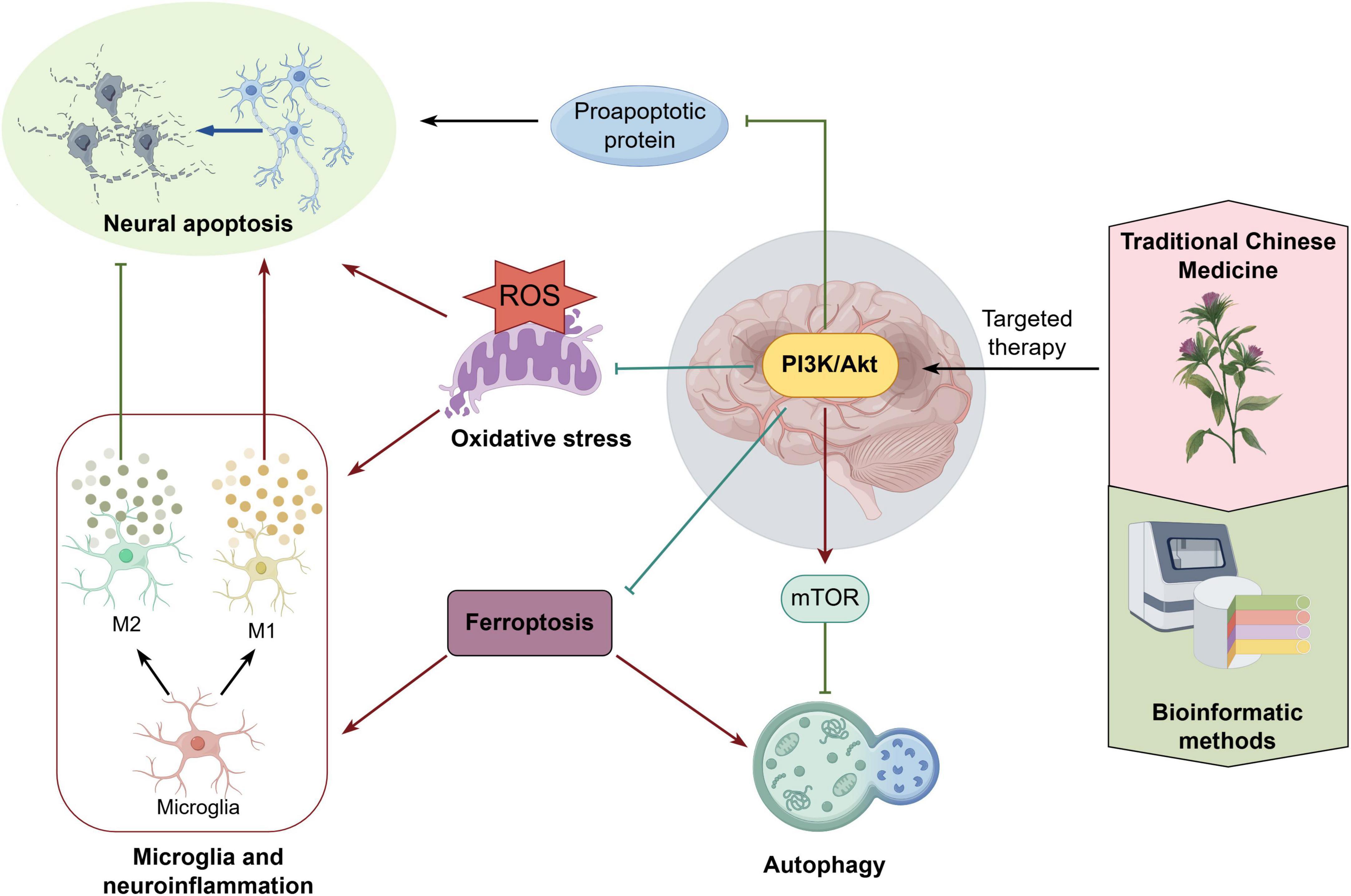
Figure 8. This figure illustrates the dynamic interrelationships among the various key regulatory mechanisms involved in the activation of the PI3K/Akt signaling pathway and their intervention strategies in IS. It encompasses current research topics of significant interest and pioneering directions in the field. Specifically, the activation of PI3K/Akt effectively inhibits oxidative stress and reduces the expression of pro-apoptotic proteins, thereby reducing neuronal apoptosis. It has been demonstrated to impede microglia M1-type polarization induced by oxidative stress, thereby attenuating neuroinflammatory injury. PI3K/Akt exerts neuroprotective effects through the regulation of downstream mTOR proteins and the inhibition of the process of autophagy. Of particular significance is the observation that the activation of PI3K/Akt has been demonstrated to inhibit ferroptosis in IS, reduce cellular autophagy, and promote microglia polarization toward an M2-type phenotype. This, in turn, has been shown to exert anti-inflammatory and repair effects. The present study explores the significance of TCM in the treatment of IS, with a particular focus on its targeted engagement with the PI3K/Akt pathway. Bioinformatics offers a scientific foundation for the efficacy of TCM, underscoring its potential as a therapeutic modality. By Figdraw.
4.4 Limitations and improvement strategies
It is imperative to acknowledge the limitations inherent in this study. During the literature screening process, the study’s scope was constrained to the WoSCC database. This decision was influenced by the recognition that prevailing software, such as VOSviewer and CiteSpace, encounter difficulties in accommodating data standardization and compatibility issues when conducting cross-database analysis. Nevertheless, this methodological approach may potentially result in the exclusion of significant research findings within this field. Concurrently, the most recent research results from January 1, 2025, to the retrieval date were not incorporated into the analysis, which could have limited the comprehensive grasp of the cutting-edge developments in IS-related PI3K/Akt research. At the technical analysis level, CiteSpace software was limited in authorship identification flaws, including its inability to distinguish between first and corresponding authors and differentiate between authors with the same name from different institutions. Furthermore, its clustering analysis was susceptible to data loss and result bias owing to the lack of parameter standardization.
These limitations may be overcome in the future through the implementation of artificial intelligence technologies. To minimize the probability of overlooking pertinent literature, it is imperative to devise intelligent cross-library standardization instruments that seamlessly integrate disparate data formats from numerous sources. When employed in conjunction with ORCID and other unique identifiers, it establishes an accurate author identification system and effectively addresses the ambiguity problem posed by scholars with identical names. The utilization of machine learning algorithms facilitates the dynamic optimization of data cleaning and parameter standardization processes. This approach is designed to mitigate the impact of data noise and systematic bias on cluster analysis. These measures are expected to enhance the depth and reliability of bibliometric results on a comprehensive scale.
5 Conclusion and prospects
For this study, we performed an objective, in-depth bibliometric analysis of high-quality literature on PI3K/Akt from the WoSCC database. We used a synergistic analysis approach with VOSviewer and CiteSpace. Using this approach, we gained a comprehensive understanding of the evolution of research in this field over the past fifteen years. We also identified current research hotspots, including pathological mechanisms such as apoptosis, autophagy, inflammation, and oxidative stress. Additionally, we identified an emerging regulatory mechanism in this field: ferroptosis. Our study reveals that combining bioinformatics technology and TCM in PI3K/Akt research for IS is key to translating basic results into clinical applications in the future. However, most RCT studies lack adequate monitoring of the adverse effects of TCM during clinical translation (Li et al., 2022). The safety issues of TCM, such as unknown toxicity, drug-drug interactions, and the risks of long-term use, need to be thoroughly investigated. Meanwhile, the bioavailability of natural active ingredients in TCM is often challenged by factors such as a strong first-pass effect and difficulty penetrating the blood-brain barrier (BBB). Additionally, there are regulatory challenges, including standardizing the quality of TCM and defining active ingredients. It is important to note that these challenges could impede the future clinical translation of PI3K/Akt research in IS. The quality control and clinical monitoring of TCM must be improved in the future to ensure safety. At the same time, advanced technologies, such as nanocarriers and structural modifications, should be used to increase bioavailability and overcome the BBB (Zhao et al., 2022). In the future, it is crucial to construct an evidence-based evaluation system that considers the complex regulatory features of TCM and meets the requirements of international drug regulatory agencies (e.g., the FDA and EMA) to promote the translation process from basic research to clinical application in the field of PI3K/Akt research in IS.
Data availability statement
The original contributions presented in the study are included in the article/Supplementary material, further inquiries can be directed to the corresponding author/s.
Author contributions
YL: Conceptualization, Data curation, Visualization, Writing – original draft. YY: Data curation, Visualization, Writing – original draft. LB: Visualization, Writing – original draft. FD: Data curation, Writing – original draft. XS: Data curation, Writing – original draft. PH: Conceptualization, Funding acquisition, Writing – review & editing. HC: Funding acquisition, Methodology, Writing – review & editing.
Funding
The author(s) declare that financial support was received for the research and/or publication of this article. This study was supported by the Translational Program of Clinical Medical Research of Anhui Province (Grant No. 202304295107020123) and the Major Program of Scientific Research of Anhui Provincial Health Commission (Grant No. AHWJ2024Aa40010).
Acknowledgments
We thank Home for Researchers editorial team (www.home-for-researchers.com) for language editing service.
Conflict of interest
The authors declare that the research was conducted in the absence of any commercial or financial relationships that could be construed as a potential conflict of interest.
Generative AI statement
The authors declare that no Generative AI was used in the creation of this manuscript.
Publisher’s note
All claims expressed in this article are solely those of the authors and do not necessarily represent those of their affiliated organizations, or those of the publisher, the editors and the reviewers. Any product that may be evaluated in this article, or claim that may be made by its manufacturer, is not guaranteed or endorsed by the publisher.
Supplementary material
The Supplementary Material for this article can be found online at: https://www.frontiersin.org/articles/10.3389/fnmol.2025.1613702/full#supplementary-material
References
Broughton, B. R. S., Reutens, D. C., and Sobey, C. G. (2009). Apoptotic mechanisms after cerebral ischemia. Stroke 40, e331–e339. doi: 10.1161/STROKEAHA.108.531632
Cai, D., Fraunfelder, M., Fujise, K., and Chen, S.-Y. (2023). ADAR1 exacerbates ischemic brain injury via astrocyte-mediated neuron apoptosis. Redox Biol. 67:102903. doi: 10.1016/j.redox.2023.102903
Chen, A., Xiong, L.-J., Tong, Y., and Mao, M. (2013). Neuroprotective effect of brain-derived neurotrophic factor mediated by autophagy through the PI3K/Akt/mTOR pathway. Mol. Med. Rep. 8, 1011–1016. doi: 10.3892/mmr.2013.1628
Chen, C. (2004). Searching for intellectual turning points: Progressive knowledge domain visualization. Proc. Natl. Acad. Sci. U.S.A. 101, 5303–5310. doi: 10.1073/pnas.0307513100
Chen, C., and Song, M. (2019). Visualizing a field of research: A methodology of systematic scientometric reviews. PLoS One 14:e0223994. doi: 10.1371/journal.pone.0223994
Chen, J., Chen, G., Xu, X., Chen, L., Zhang, J., and Liu, F. (2023). Bibliometric analysis and visualized study of research on autophagy in ischemic stroke. Front. Pharmacol. 14:1232114. doi: 10.3389/fphar.2023.1232114
Chen, J., Zhang, X., Liu, X., Zhang, C., Shang, W., Xue, J., et al. (2019). Ginsenoside Rg1 promotes cerebral angiogenesis via the PI3K/Akt/mTOR signaling pathway in ischemic mice. Eur. J. Pharmacol. 856:172418. doi: 10.1016/j.ejphar.2019.172418
Chen, X., Chen, H., He, Y., Fu, S., Liu, H., Wang, Q., et al. (2020). Proteomics-guided study on buyang huanwu decoction for its neuroprotective and neurogenic mechanisms for transient ischemic stroke: Involvements of EGFR/PI3K/Akt/Bad/14-3-3 and Jak2/Stat3/Cyclin D1 signaling cascades. Mol. Neurobiol. 57, 4305–4321. doi: 10.1007/s12035-020-02016-y
Doyle, K. P., Simon, R. P., and Stenzel-Poore, M. P. (2008). Mechanisms of ischemic brain damage. Neuropharmacology 55, 310–318. doi: 10.1016/j.neuropharm.2008.01.005
Duan, Z., Chen, H., Miao, W., He, J., Xu, D., Qi, Z., et al. (2024). Scutellarin alleviates microglia−mediated neuroinflammation and apoptosis after ischemic stroke through the PI3K/AKT/GSK3 β signaling pathway. J. Cell Commun. Signal. 18:e12023. doi: 10.1002/ccs3.12023
Elmore, S. (2007). Apoptosis: A review of programmed cell death. Toxicol. Pathol. 35, 495–516. doi: 10.1080/01926230701320337
Engelman, J. A., Luo, J., and Cantley, L. C. (2006). The evolution of phosphatidylinositol 3-kinases as regulators of growth and metabolism. Nat. Rev. Genet. 7, 606–619. doi: 10.1038/nrg1879
Feigin, V. L., Stark, B. A., Johnson, C. O., Roth, G. A., Bisignano, C., Abady, G. G., et al. (2021). Global, regional, and national burden of stroke and its risk factors, 1990–2019: A systematic analysis for the global burden of disease study 2019. Lancet Neurol. 20, 795–820. doi: 10.1016/S1474-4422(21)00252-0
Feng, C., Wan, H., Zhang, Y., Yu, L., Shao, C., He, Y., et al. (2020). Neuroprotective effect of danhong injection on cerebral ischemia-reperfusion injury in rats by activation of the PI3K-Akt pathway. Front. Pharmacol. 11:298. doi: 10.3389/fphar.2020.00298
Fleisher, T. A. (1997). Apoptosis. Ann. Allergy Asthma Immunol. 78, 245–250. doi: 10.1016/S1081-1206(10)63176-6
Fu, C., Wu, Y., Liu, S., Luo, C., Lu, Y., Liu, M., et al. (2022). Rehmannioside A improves cognitive impairment and alleviates ferroptosis via activating PI3K/AKT/Nrf2 and SLC7A11/GPX4 signaling pathway after ischemia. J. Ethnopharmacol. 289:115021. doi: 10.1016/j.jep.2022.115021
He, H., Zeng, Q., Huang, G., Lin, Y., Lin, H., Liu, W., et al. (2019). Bone marrow mesenchymal stem cell transplantation exerts neuroprotective effects following cerebral ischemia/reperfusion injury by inhibiting autophagy via the PI3K/Akt pathway. Brain Res. 1707, 124–132. doi: 10.1016/j.brainres.2018.11.018
He, X., Wu, M., Chen, L., Liu, M., Hu, X., Meng, Y., et al. (2024). APMCG-1 attenuates ischemic stroke injury by reducing oxidative stress and apoptosis and promoting angiogenesis via activating PI3K/AKT pathway. Biomed. Pharmacother. 180:117506. doi: 10.1016/j.biopha.2024.117506
Hilkens, N. A., Casolla, B., Leung, T. W., and de Leeuw, F.-E. (2024). Stroke. Lancet 403, 2820–2836. doi: 10.1016/S0140-6736(24)00642-1
Hou, Y., Wang, K., Wan, W., Cheng, Y., Pu, X., and Ye, X. (2018). Resveratrol provides neuroprotection by regulating the JAK2/STAT3/PI3K/AKT/mTOR pathway after stroke in rats. Genes Dis. 5, 245–255. doi: 10.1016/j.gendis.2018.06.001
Huang, L., Chen, C., Zhang, X., Li, X., Chen, Z., Yang, C., et al. (2018). Neuroprotective effect of curcumin against cerebral ischemia-reperfusion via mediating autophagy and inflammation. J. Mol. Neurosci. 64, 129–139. doi: 10.1007/s12031-017-1006-x
Jayaraj, R. L., Azimullah, S., Beiram, R., Jalal, F. Y., and Rosenberg, G. A. (2019). Neuroinflammation: Friend and foe for ischemic stroke. J. Neuroinflamm. 16:142. doi: 10.1186/s12974-019-1516-2
Jiang, N., Yang, T., Han, H., Shui, J., Hou, M., Wei, W., et al. (2024). Exploring research trend and hotspots on oxidative stress in ischemic stroke (2001–2022): Insights from bibliometric. Mol. Neurobiol. 61, 6200–6216. doi: 10.1007/s12035-023-03909-4
Katso, R., Okkenhaug, K., Ahmadi, K., White, S., Timms, J., and Waterfield, M. D. (2001). Cellular function of phosphoinositide 3-kinases: Implications for development, immunity, homeostasis, and cancer. Annu. Rev. Cell Dev. Biol. 17, 615–675. doi: 10.1146/annurev.cellbio.17.1.615
Kilic, U., Caglayan, A. B., Beker, M. C., Gunal, M. Y., Caglayan, B., Yalcin, E., et al. (2017). Particular phosphorylation of PI3K/Akt on Thr308 via PDK-1 and PTEN mediates melatonin’s neuroprotective activity after focal cerebral ischemia in mice. Redox Biol. 12, 657–665. doi: 10.1016/j.redox.2017.04.006
Li, L., Jiang, W., Yu, B., Liang, H., Mao, S., Hu, X., et al. (2023). Quercetin improves cerebral ischemia/reperfusion injury by promoting microglia/macrophages M2 polarization via regulating PI3K/Akt/NF-κB signaling pathway. Biomed. Pharmacother. 168:115653. doi: 10.1016/j.biopha.2023.115653
Li, L., Shao, C., Liu, Z., Wu, X., Yang, J., and Wan, H. (2022). Comparative efficacy of Honghua class injections for treating acute ischemic stroke: A Bayesian network meta-analysis of randomized controlled trials. Front. Pharmacol. 13:1010533. doi: 10.3389/fphar.2022.1010533
Li, W., Yang, Y., Hu, Z., Ling, S., and Fang, M. (2015). Neuroprotective effects of DAHP and Triptolide in focal cerebral ischemia via apoptosis inhibition and PI3K/Akt/mTOR pathway activation. Front. Neuroanat. 9:48. doi: 10.3389/fnana.2015.00048
Liu, C., Wu, J., Xu, K., Cai, F., Gu, J., Ma, L., et al. (2010). Neuroprotection by baicalein in ischemic brain injury involves PTEN/AKT pathway. J. Neurochem. 112, 1500–1512. doi: 10.1111/j.1471-4159.2009.06561.x
Liu, S., Yao, S., Yang, H., Liu, S., and Wang, Y. (2023). Autophagy: Regulator of cell death. Cell Death Dis. 14:648. doi: 10.1038/s41419-023-06154-8
Liu, T., Li, X., Zhou, X., Chen, W., Wen, A., Liu, M., et al. (2025). PI3K/AKT signaling and neuroprotection in ischemic stroke: Molecular mechanisms and therapeutic perspectives. Neural Regen. Res. 20, 2758–2775. doi: 10.4103/NRR.NRR-D-24-00568
Liu, T., Wang, W., Li, X., Chen, Y., Mu, F., Wen, A., et al. (2023). Advances of phytotherapy in ischemic stroke targeting PI3K/Akt signaling. Phytother. Res. 37, 5509–5528. doi: 10.1002/ptr.7994
Longa, E. Z., Weinstein, P. R., Carlson, S., and Cummins, R. (1989). Reversible middle cerebral artery occlusion without craniectomy in rats. Stroke 20, 84–91. doi: 10.1161/01.STR.20.1.84
Lv, H., Lu, K., Wang, X., Zhang, Y., Zhuang, M., Li, J., et al. (2025). Recent trends in research on the role of cholesterol in leukemia: A bibliometric and visualization study. Front. Immunol. 16:1511827. doi: 10.3389/fimmu.2025.1511827
Meng, J., Ma, H., Zhu, Y., and Zhao, Q. (2021). Dehydrocostuslactone attenuated oxygen and glucose deprivation/reperfusion-induced PC12 cell injury through inhibition of apoptosis and autophagy by activating the PI3K/AKT/mTOR pathway. Eur. J. Pharmacol. 911:174554. doi: 10.1016/j.ejphar.2021.174554
Min, X., He, M., Shi, Y., Xie, L., Ma, X., and Cao, Y. (2020). miR-18b attenuates cerebral ischemia/reperfusion injury through regulation of ANXA3 and PI3K/Akt signaling pathway. Brain Res. Bull. 161, 55–64. doi: 10.1016/j.brainresbull.2020.04.021
Murray, P. J., Allen, J. E., Biswas, S. K., Fisher, E. A., Gilroy, D. W., Goerdt, S., et al. (2014). Macrophage activation and polarization: Nomenclature and experimental guidelines. Immunity 41, 14–20. doi: 10.1016/j.immuni.2014.06.008
Niizuma, K., Endo, H., and Chan, P. H. (2009). Oxidative stress and mitochondrial dysfunction as determinants of ischemic neuronal death and survival. J. Neurochem. 109, 133–138. doi: 10.1111/j.1471-4159.2009.05897.x
Perez-Alvarez, M. J., Villa Gonzalez, M., Benito-Cuesta, I., and Wandosell, F. G. (2018). Role of mTORC1 controlling proteostasis after brain ischemia. Front. Neurosci. 12:60. doi: 10.3389/fnins.2018.00060
Ravindran, K., Kurda, D., Maingard, J., Phan, K., Kok, H. K., Thijs, V., et al. (2019). The 100 most cited articles in the endovascular management of acute ischemic stroke. J. Neurointerv. Surg. 11, 785–789. doi: 10.1136/neurintsurg-2018-014600
Ri, M. H., Xing, Y., Zuo, H. X., Li, M. Y., Jin, H. L., Ma, J., et al. (2023). Regulatory mechanisms of natural compounds from traditional Chinese herbal medicines on the microglial response in ischemic stroke. Phytomedicine 116:154889. doi: 10.1016/j.phymed.2023.154889
Samakova, A., Gazova, A., Sabova, N., Valaskova, S., Jurikova, M., and Kyselovic, J. (2019). The PI3k/Akt pathway is associated with angiogenesis, oxidative stress and survival of mesenchymal stem cells in pathophysiologic condition in ischemia. Physiol. Res. 68, S131–S138. doi: 10.33549/physiolres.934345
Sies, H. (2015). Oxidative stress: A concept in redox biology and medicine. Redox Biol. 4, 180–183. doi: 10.1016/j.redox.2015.01.002
Tuo, Q., Zhang, S., and Lei, P. (2022). Mechanisms of neuronal cell death in ischemic stroke and their therapeutic implications. Med. Res. Rev. 42, 259–305. doi: 10.1002/med.21817
van Eck, N. J., and Waltman, L. (2010). Software survey: VOSviewer, a computer program for bibliometric mapping. Scientometrics 84, 523–538. doi: 10.1007/s11192-009-0146-3
Veiga-del-Baño, J. M., Cámara, M. Á, Oliva, J., Hernández-Cegarra, A. T., Andreo-Martínez, P., and Motas, M. (2023). Mapping of emerging contaminants in coastal waters research: A bibliometric analysis of research output during 1986–2022. Mar. Pollut. Bull. 194:115366. doi: 10.1016/j.marpolbul.2023.115366
Wang, P., Shao, B.-Z., Deng, Z., Chen, S., Yue, Z., and Miao, C.-Y. (2018). Autophagy in ischemic stroke. Prog. Neurobiol. 163–164, 98–117. doi: 10.1016/j.pneurobio.2018.01.001
Wang, Z., Li, M., Li, W., Ouyang, J., Gou, X., and Huang, Y. (2023). Mechanism of action of Daqinjiao decoction in treating cerebral small vessel disease explored using network pharmacology and molecular docking technology. Phytomedicine 108:154538. doi: 10.1016/j.phymed.2022.154538
Wooller, S. K., Benstead-Hume, G., Chen, X., Ali, Y., and Pearl, F. M. G. (2017). Bioinformatics in translational drug discovery. Biosci. Rep. 37:BSR20160180. doi: 10.1042/BSR20160180
Wu, S., Cheng, Y., Wu, B., and Liu, M. (2020). Stroke research in 2019: Towards optimising treatment and prevention. Lancet Neurol. 19, 2–3. doi: 10.1016/S1474-4422(19)30448-X
Xie, W., Zhou, P., Sun, Y., Meng, X., Dai, Z., Sun, G., et al. (2018). Protective effects and target network analysis of ginsenoside Rg1 in cerebral ischemia and reperfusion injury: A comprehensive overview of experimental studies. Cells 7:270. doi: 10.3390/cells7120270
Xie, Y., Shi, X., Sheng, K., Han, G., Li, W., Zhao, Q., et al. (2018). PI3K/Akt signaling transduction pathway, erythropoiesis and glycolysis in hypoxia (Review). Mol. Med. Rep. 19, 783–791. doi: 10.3892/mmr.2018.9713
Xu, F., Dai, Z., Ye, Y., Hu, P., and Cheng, H. (2024). Bibliometric and visualized analysis of the application of artificial intelligence in stroke. Front. Neurosci. 18:1411538. doi: 10.3389/fnins.2024.1411538
Xu, S., Lu, J., Shao, A., Zhang, J. H., and Zhang, J. (2020). Glial cells: Role of the immune response in ischemic stroke. Front. Immunol. 11:294. doi: 10.3389/fimmu.2020.00294
Xu, Y., Chen, W., Chen, Z., Huang, M., Yang, F., and Zhang, Y. (2021). Mechanism of action of xiaoyao san in treatment of ischemic stroke is related to anti-apoptosis and activation of PI3K/Akt pathway. Drug Des. Dev. Ther. 15, 753–767. doi: 10.2147/DDDT.S280217
Xu, Y., Wen, K., Liu, A., Wang, X., Xu, H., and Wen, H. (2023). Efficacy of curculigoside in protecting against ischemic brain injury through regulation of oxidative stress and NF-κB and PI3K/Akt expression. J. Ethnopharmacol. 301:115804. doi: 10.1016/j.jep.2022.115804
Yan, Y., Liu, Y., Yang, Y., Ding, Y., and Sun, X. (2022). Carnosol suppresses microglia cell inflammation and apoptosis through PI3K/AKT/mTOR signaling pathway. Immunopharmacol. Immunotoxicol. 44, 656–662. doi: 10.1080/08923973.2022.2074448
Yang, F., Chen, Z.-R., Yang, X.-H., Xu, Y., Ran, N.-J., Liu, M.-J., et al. (2022). Monomethyl lithospermate alleviates ischemic stroke injury in middle cerebral artery occlusion mice in vivo and protects oxygen glucose deprivation/reoxygenation induced SHSY-5Y cells in vitro via activation of PI3K/Akt signaling. Front. Pharmacol. 13:1024439. doi: 10.3389/fphar.2022.1024439
Yang, J., Deng, Y., Cai, Y., Liu, Y., Peng, L., Luo, Z., et al. (2022). Mapping trends and hotspot regarding gastrointestinal microbiome and neuroscience: A bibliometric analysis of global research (2002–2022). Front. Neurosci. 16:1048565. doi: 10.3389/fnins.2022.1048565
Yang, J., Nie, J., Ma, X., Wei, Y., Peng, Y., and Wei, X. (2019). Targeting PI3K in cancer: Mechanisms and advances in clinical trials. Mol. Cancer 18:26. doi: 10.1186/s12943-019-0954-x
Yang, Y., He, Y., Wei, X., Wan, H., Ding, Z., Yang, J., et al. (2022). Network pharmacology and molecular docking-based mechanism study to reveal the protective effect of salvianolic acid c in a rat model of ischemic stroke. Front. Pharmacol. 12:799448. doi: 10.3389/fphar.2021.799448
Yao, R.-Q., Qi, D.-S., Yu, H.-L., Liu, J., Yang, L.-H., and Wu, X.-X. (2012). Quercetin attenuates cell apoptosis in focal cerebral ischemia rat brain via activation of BDNF–TrkB–PI3K/Akt signaling pathway. Neurochem. Res. 37, 2777–2786. doi: 10.1007/s11064-012-0871-5
Yu, Z.-H., Cai, M., Xiang, J., Zhang, Z.-N., Zhang, J.-S., Song, X.-L., et al. (2016). PI3K/Akt pathway contributes to neuroprotective effect of Tongxinluo against focal cerebral ischemia and reperfusion injury in rats. J. Ethnopharmacol. 181, 8–19. doi: 10.1016/j.jep.2016.01.028
Yuan, Y., Guo, Q., Ye, Z., Pingping, X., Wang, N., and Song, Z. (2011). Ischemic postconditioning protects brain from ischemia/reperfusion injury by attenuating endoplasmic reticulum stress-induced apoptosis through PI3K-Akt pathway. Brain Res. 1367, 85–93. doi: 10.1016/j.brainres.2010.10.017
Yuan, Y., Sheng, P., Ma, B., Xue, B., Shen, M., Zhang, L., et al. (2023). Elucidation of the mechanism of Yiqi Tongluo Granule against cerebral ischemia/reperfusion injury based on a combined strategy of network pharmacology, multi-omics and molecular biology. Phytomedicine 118:154934. doi: 10.1016/j.phymed.2023.154934
Zhang, C., Chopp, M., Cui, Y., Wang, L., Zhang, R., Zhang, L., et al. (2010). Cerebrolysin enhances neurogenesis in the ischemic brain and improves functional outcome after stroke. J. Neurosci. Res. 88, 3275–3281. doi: 10.1002/jnr.22495
Zhang, J., Song, L., Xu, L., Fan, Y., Wang, T., Tian, W., et al. (2021). Knowledge domain and emerging trends in ferroptosis research: A bibliometric and knowledge-map analysis. Front. Oncol. 11:686726. doi: 10.3389/fonc.2021.686726
Zhang, X., Wang, X., Yin, L., Wang, D., Jiao, H., Liu, X., et al. (2024). HACE1 exerts a neuroprotective role against oxidative stress in cerebral ischemia–reperfusion injury by activating the PI3K/AKT/Nrf2 pathway. Neuroscience 559, 249–262. doi: 10.1016/j.neuroscience.2024.09.002
Zhang, Y., Li, Y., and Liu, F. (2024). AEBP1 silencing protects against cerebral ischemia/reperfusion injury by regulating neuron ferroptosis and microglia M2 Polarization through PRKCA-PI3K-Akt Axis. Drug Dev. Res. 85:e70032. doi: 10.1002/ddr.70032
Zhao, F., Peng, C., Li, H., Chen, H., Yang, Y., Ai, Q., et al. (2023). Paeoniae Radix Rubra extract attenuates cerebral ischemia injury by inhibiting ferroptosis and activating autophagy through the PI3K/Akt signalling pathway. J. Ethnopharmacol. 315:116567. doi: 10.1016/j.jep.2023.116567
Zhao, G., Hong, L., Liu, M., Jiang, H., Peng, D., He, L., et al. (2022). Isolation and characterization of natural nanoparticles in naoluo xintong decoction and their brain protection research. Molecules 27:1511. doi: 10.3390/molecules27051511
Zheng, L.-S., Ishii, Y., Zhao, Q.-L., Kondo, T., and Sasahara, M. (2013). PDGF suppresses oxidative stress induced Ca 2+ overload and calpain activation in neurons. Oxid. Med. Cell. Longev. 2013, 1–8. doi: 10.1155/2013/367206
Zheng, T., Jiang, T., Ma, H., Zhu, Y., and Wang, M. (2024). Targeting PI3K/Akt in cerebral ischemia reperfusion injury alleviation: From signaling networks to targeted therapy. Mol. Neurobiol. 61, 7930–7949. doi: 10.1007/s12035-024-04039-1
Zhou, H., He, Y., Zhu, J., Lin, X., Chen, J., Shao, C., et al. (2021). Guhong injection protects against apoptosis in cerebral ischemia by maintaining cerebral microvasculature and mitochondrial integrity through the PI3K/AKT pathway. Front. Pharmacol. 12:650983. doi: 10.3389/fphar.2021.650983
Zhu, H., Zhang, Y., Feng, S., Li, Y., Ye, Y., Jian, Z., et al. (2023). Trends in NLRP3 inflammasome research in ischemic stroke from 2011 to 2022: A bibliometric analysis. CNS Neurosci. Ther. 29, 2940–2954. doi: 10.1111/cns.14232
Keywords: PI3K/AKT, signaling pathways, bibliometric analysis, ischemic stroke, visual analysis, scientific networks
Citation: Liu Y, Ye Y, Bai L, Dai F, Su X, Hu P and Cheng H (2025) Exploring research trends and hotspots in PI3K/Akt signaling pathway in ischemic stroke: a bibliometric analysis. Front. Mol. Neurosci. 18:1613702. doi: 10.3389/fnmol.2025.1613702
Received: 17 April 2025; Accepted: 02 June 2025;
Published: 23 June 2025.
Edited by:
Atif Khurshid Wani, Lovely Professional University, IndiaReviewed by:
Manish Shukla, Penn State Milton S. Hershey Medical Center, United StatesSabyasachi Mohanty, University of Nebraska-Lincoln, United States
Simna Saraswathi Prasannakumari, University of North Carolina at Chapel Hill, United States
Copyright © 2025 Liu, Ye, Bai, Dai, Su, Hu and Cheng. This is an open-access article distributed under the terms of the Creative Commons Attribution License (CC BY). The use, distribution or reproduction in other forums is permitted, provided the original author(s) and the copyright owner(s) are credited and that the original publication in this journal is cited, in accordance with accepted academic practice. No use, distribution or reproduction is permitted which does not comply with these terms.
*Correspondence: Peijia Hu, emp5eWhwakAxNjMuY29t; Hongliang Cheng, Y2hsLjc1ODExQDE2My5jb20=
 Yingquan Liu
Yingquan Liu Yu Ye
Yu Ye Lin Bai
Lin Bai Fan Dai
Fan Dai Xingxing Su3
Xingxing Su3 Hongliang Cheng
Hongliang Cheng